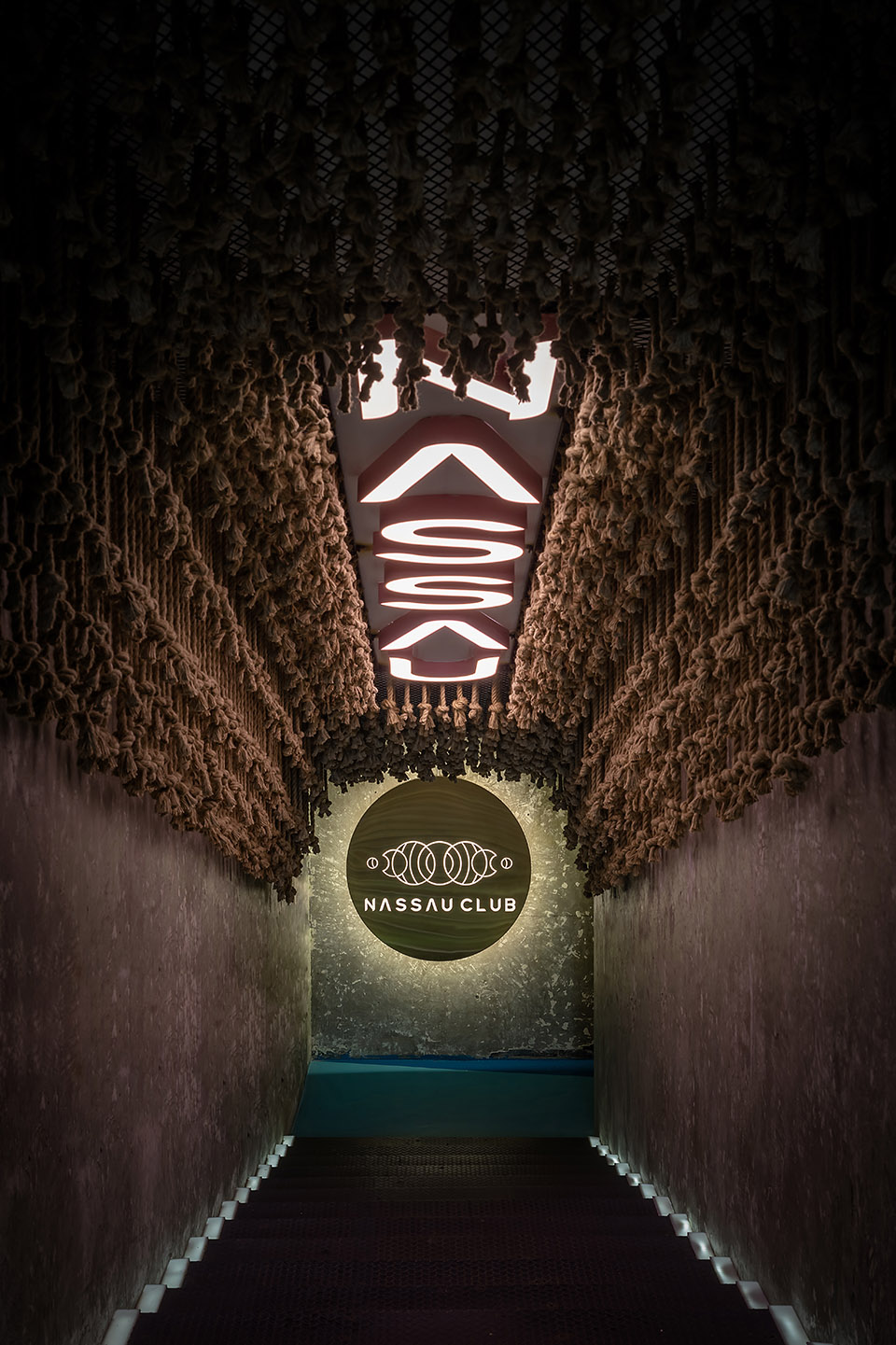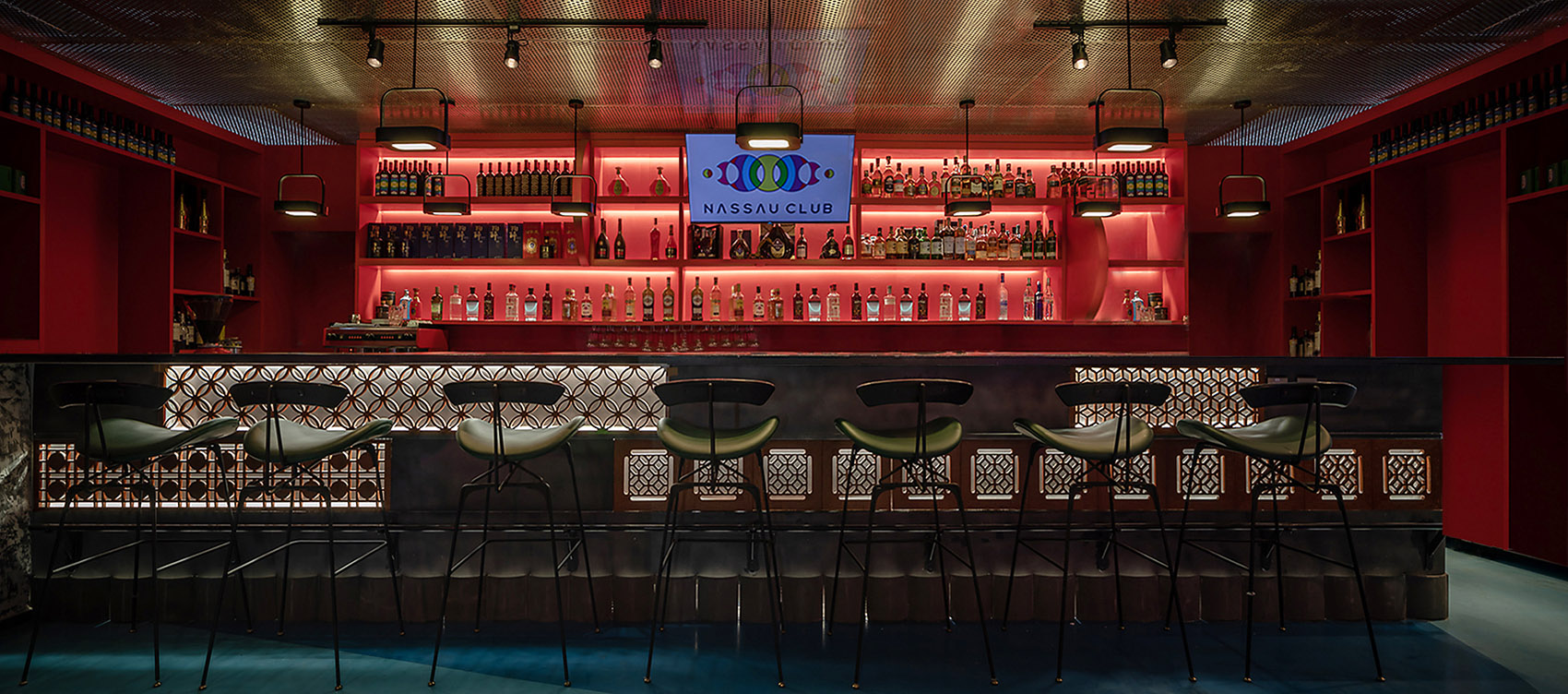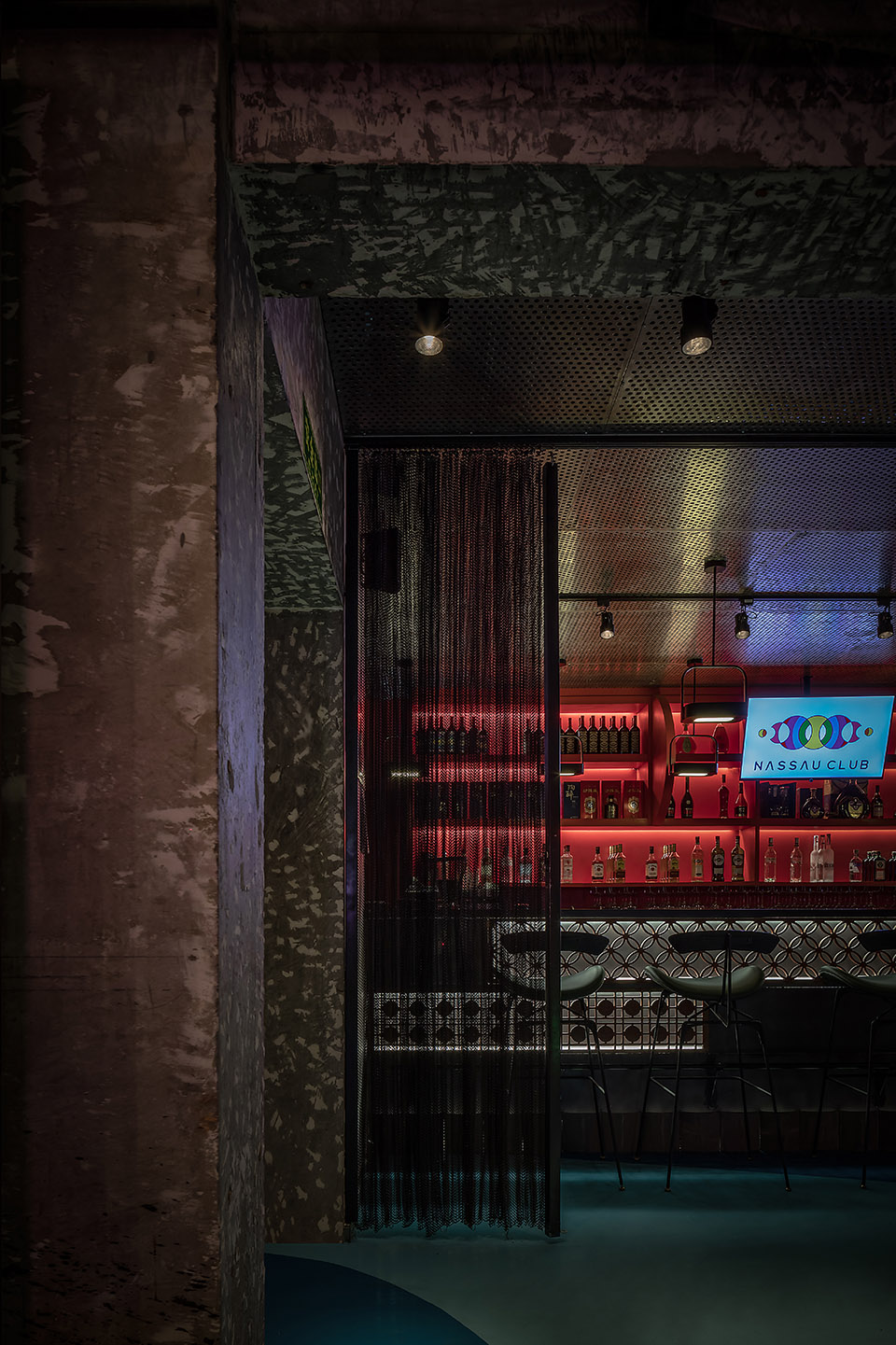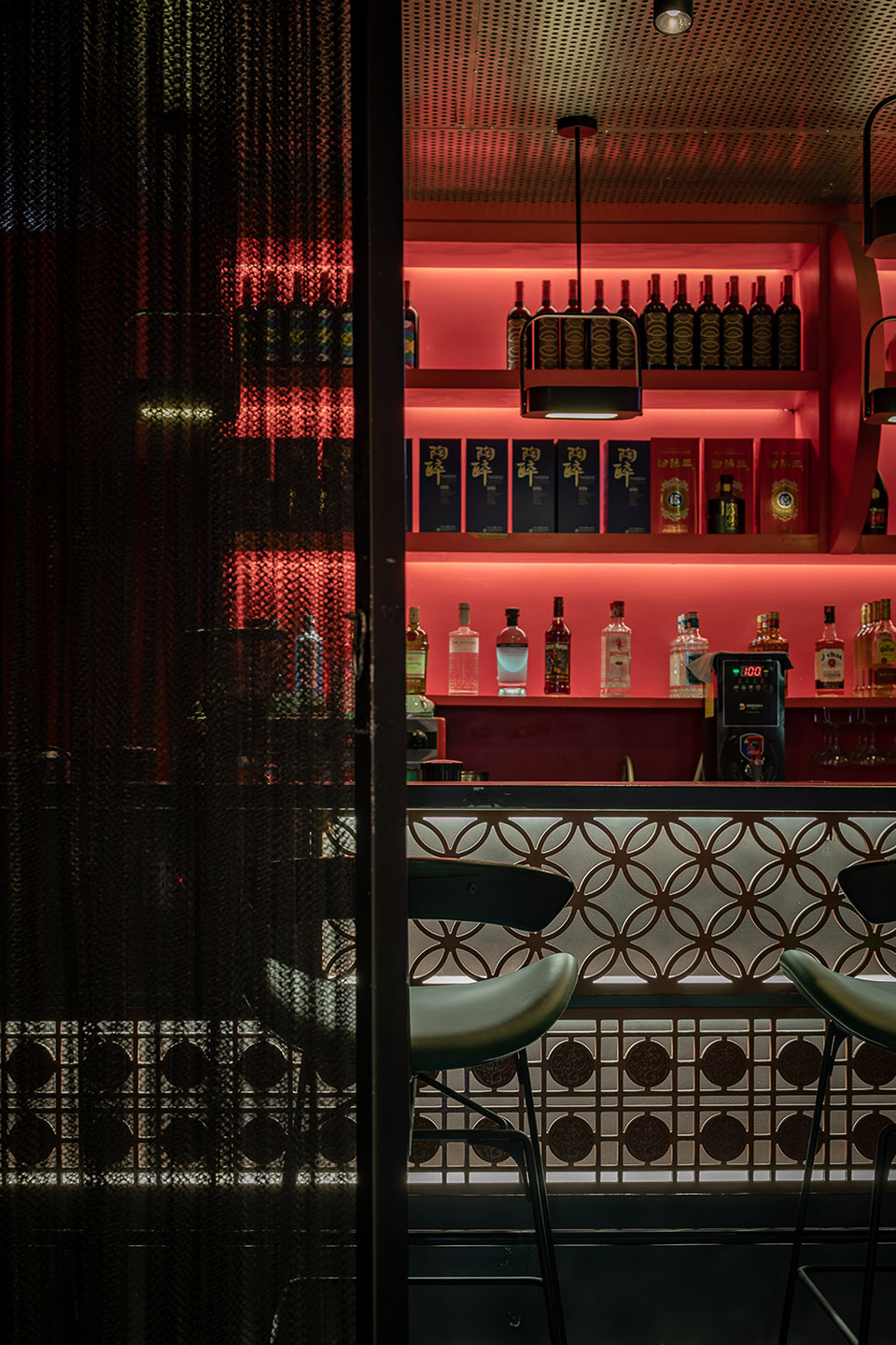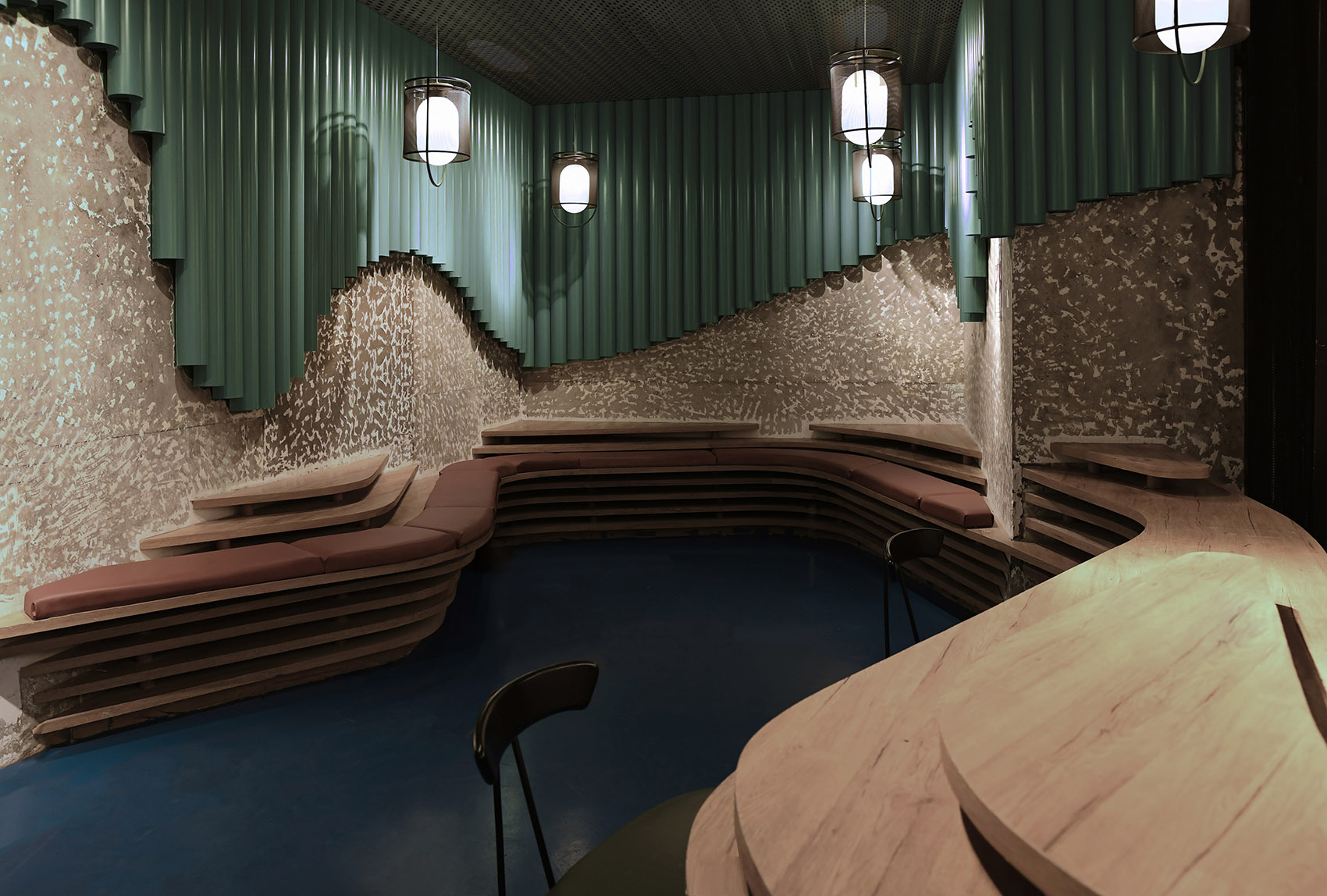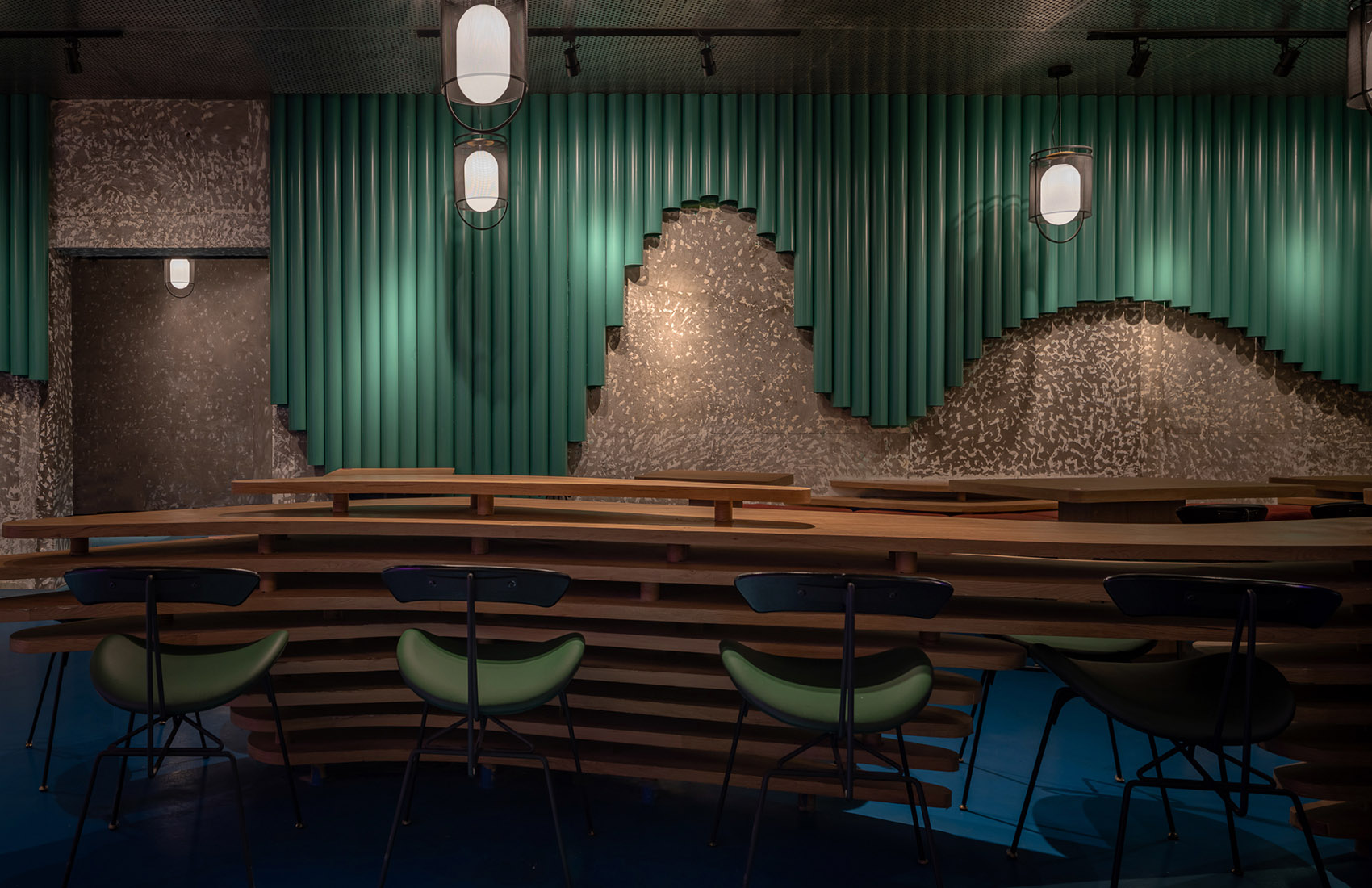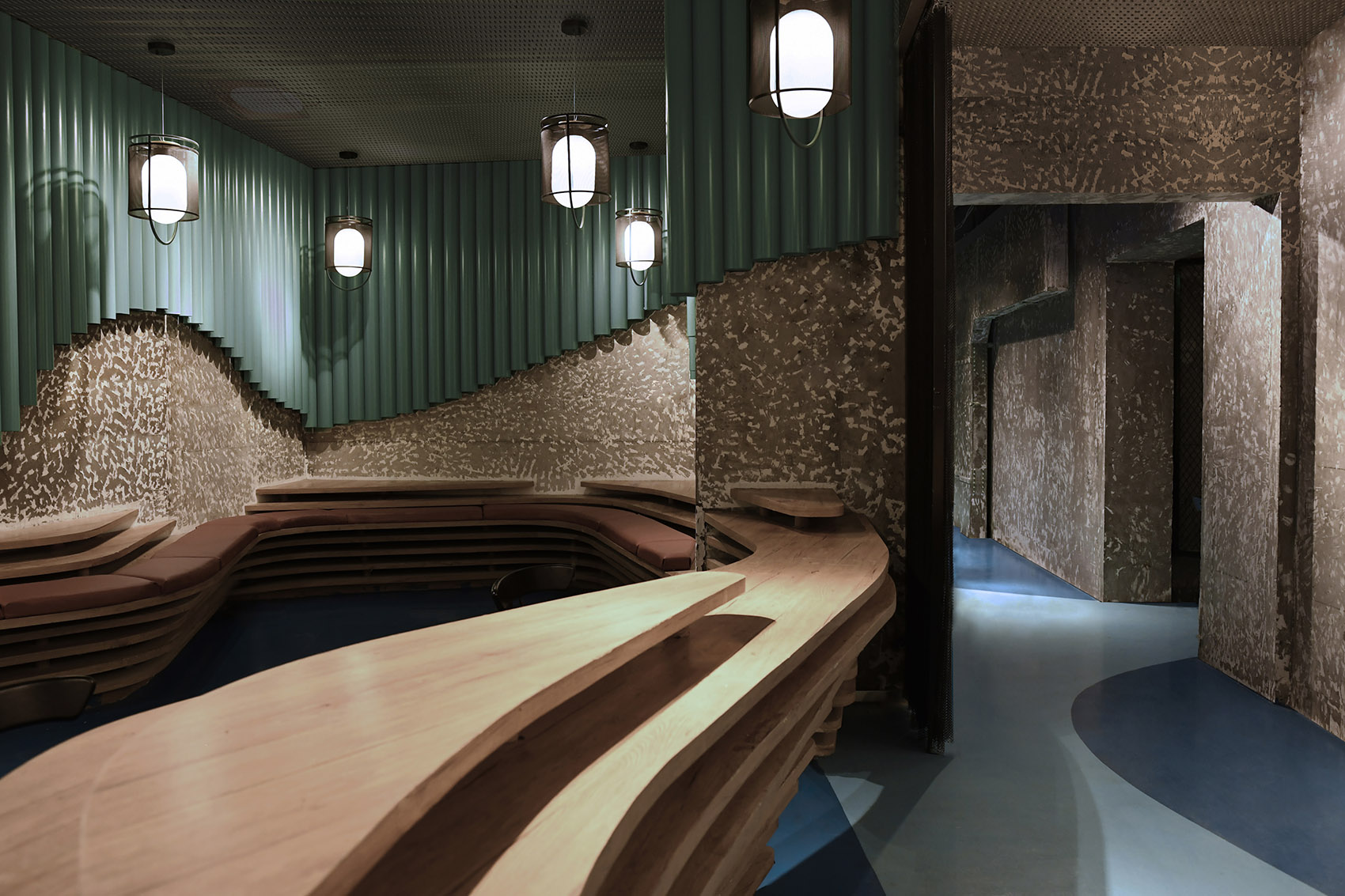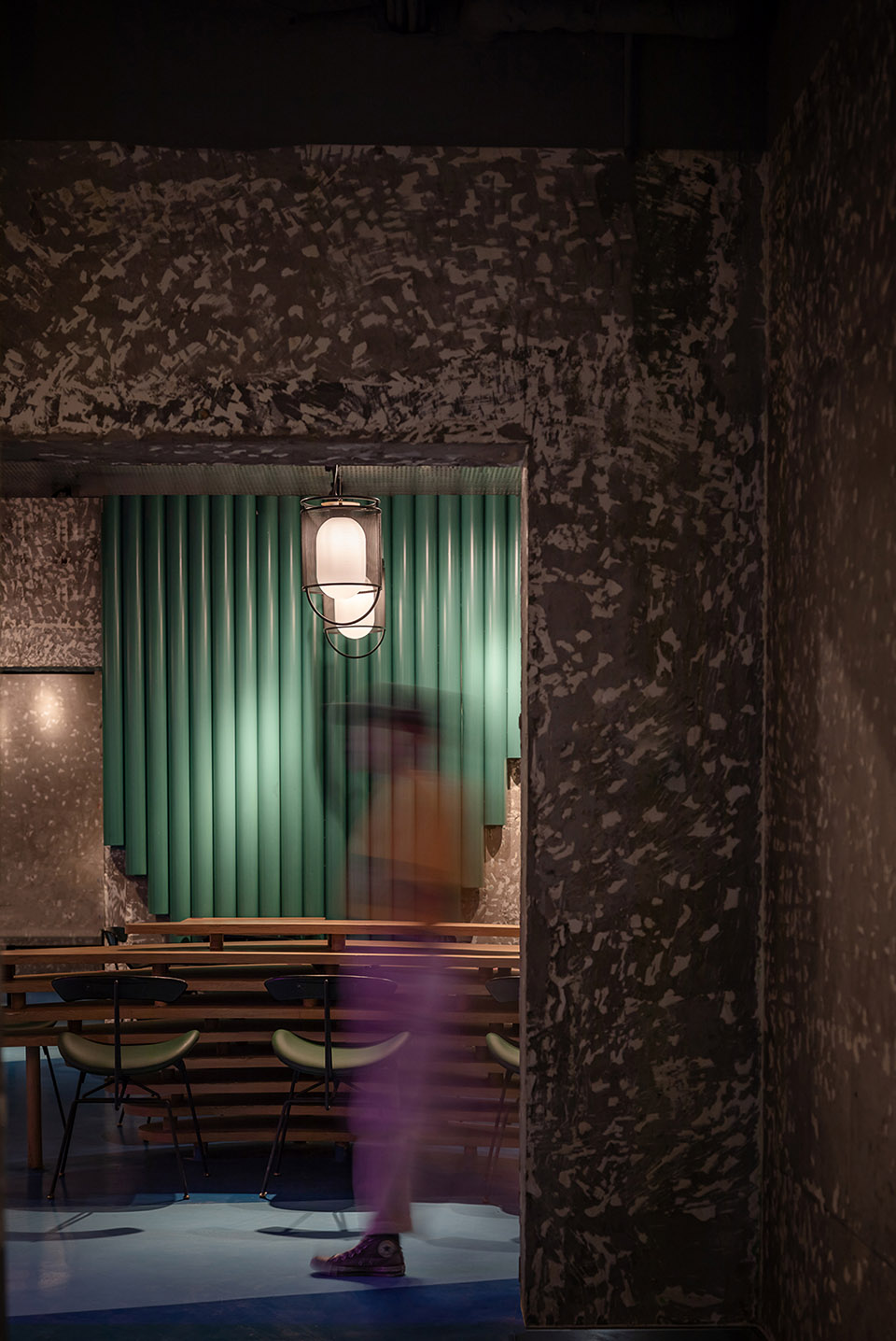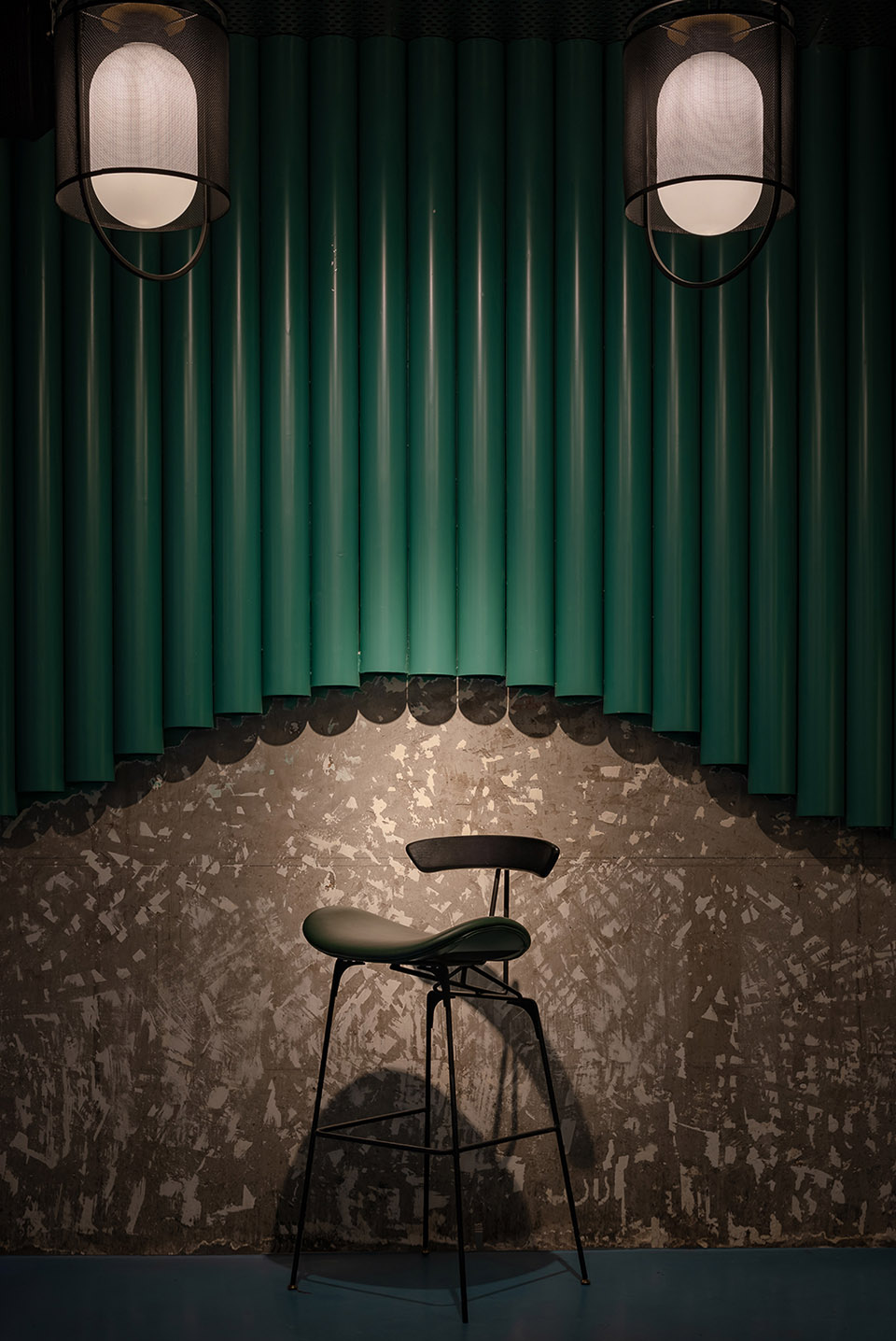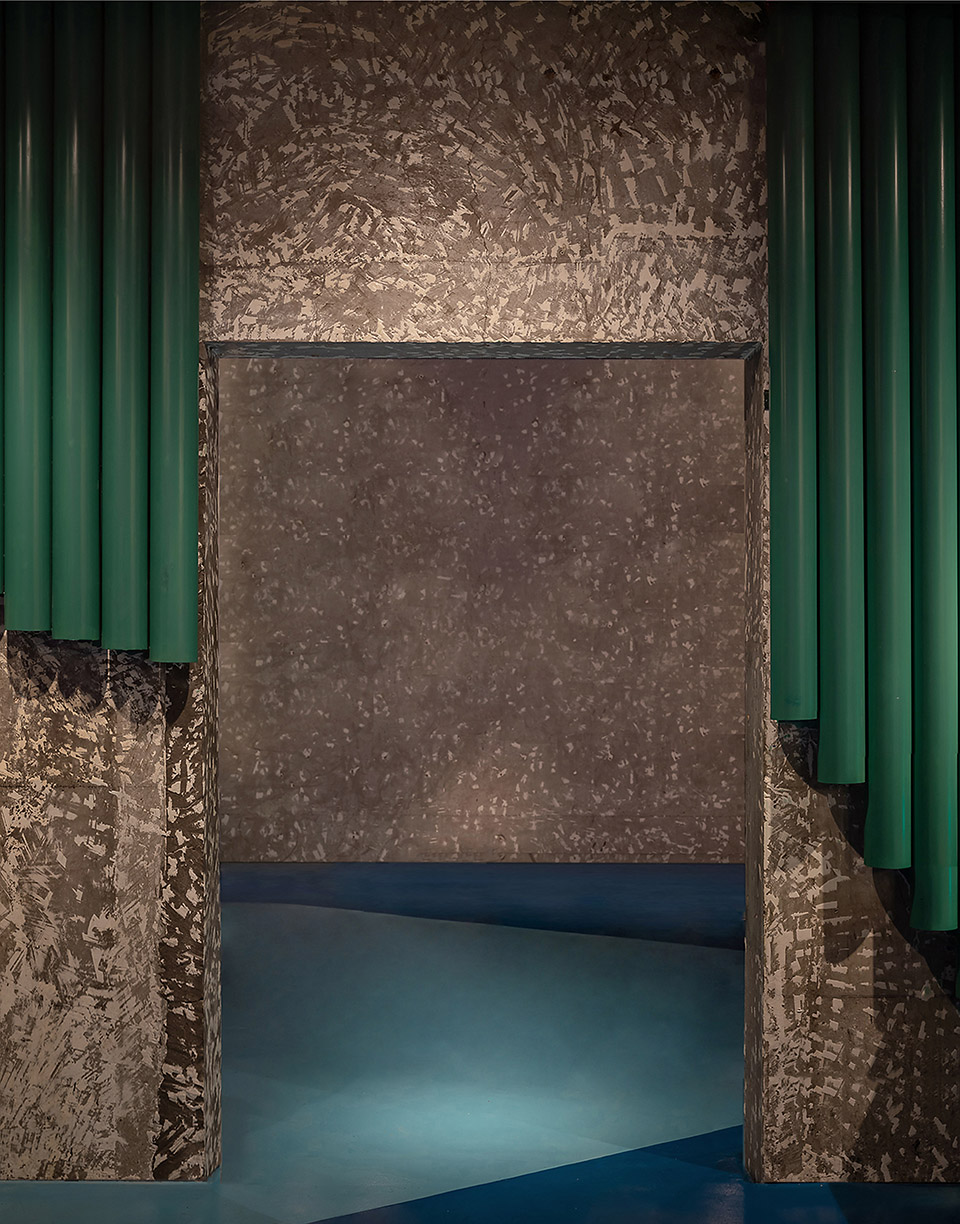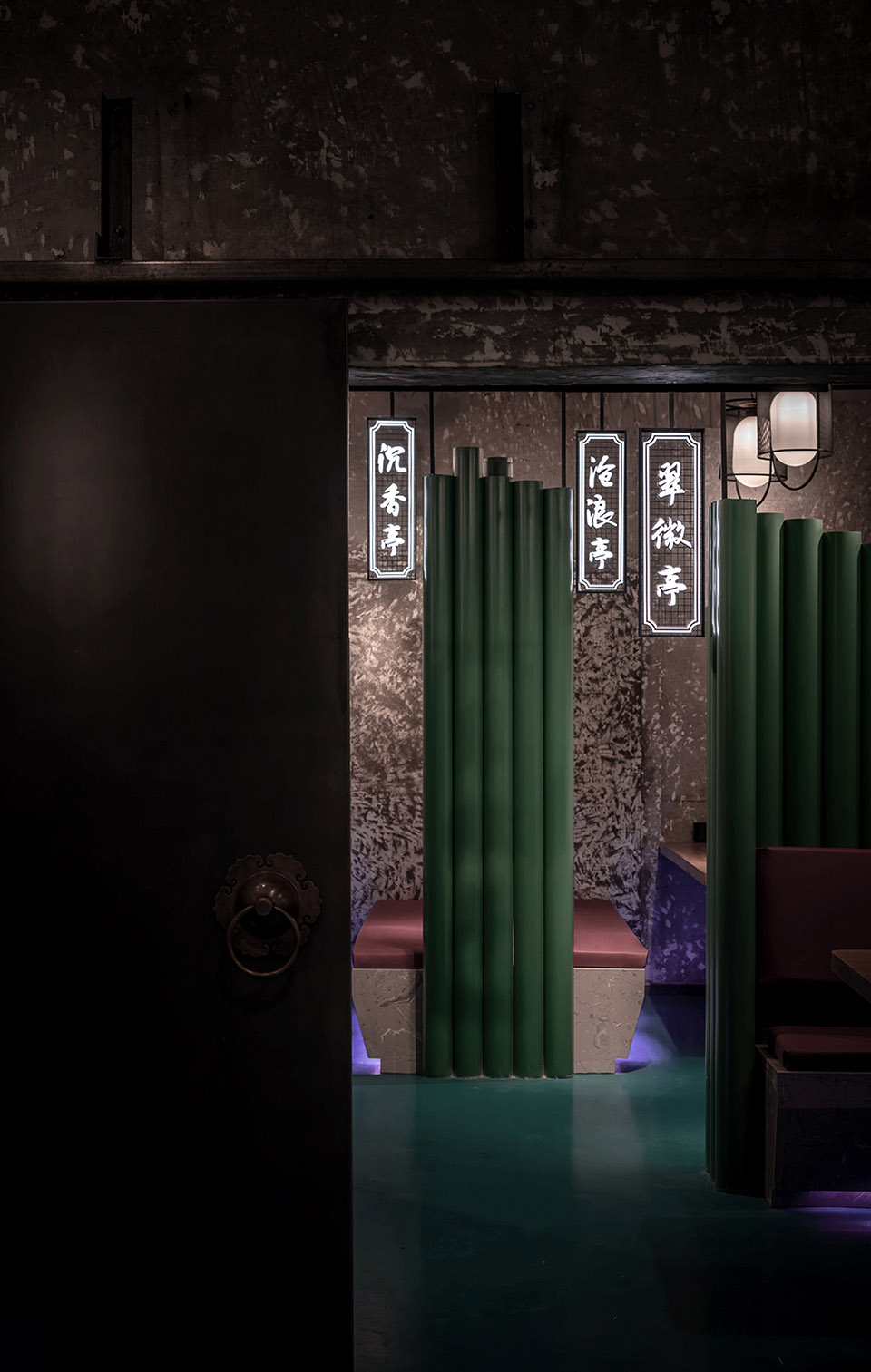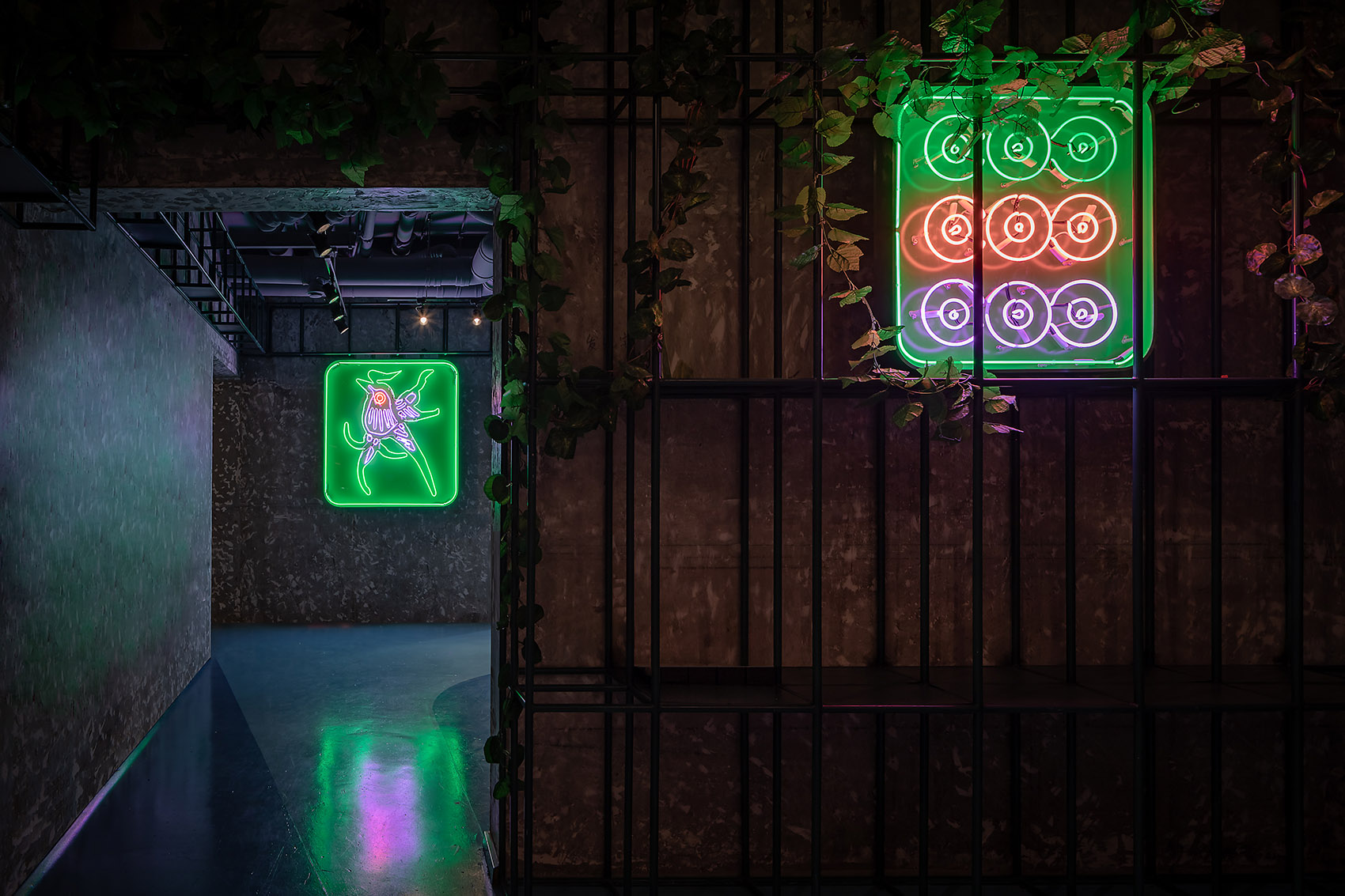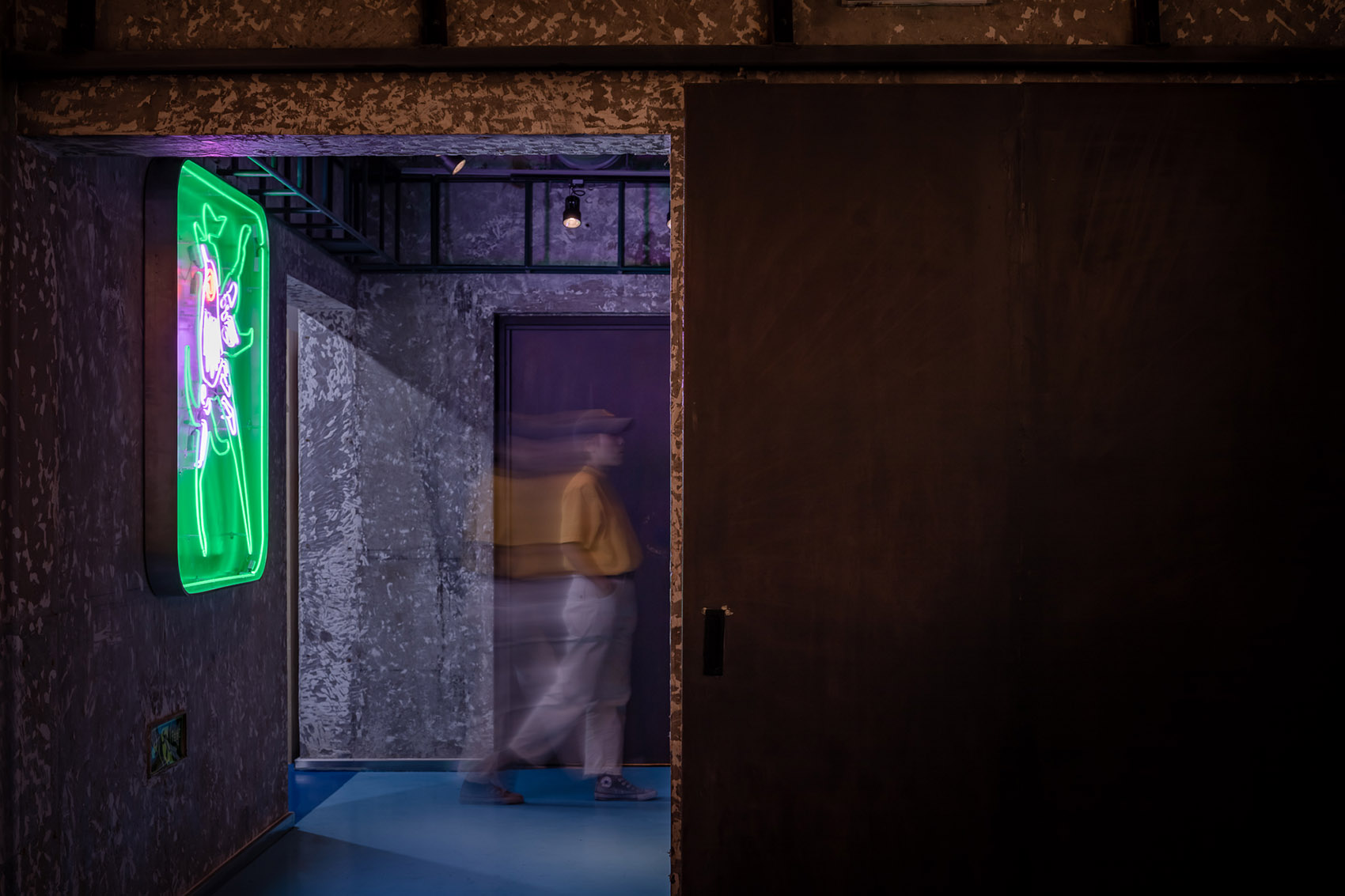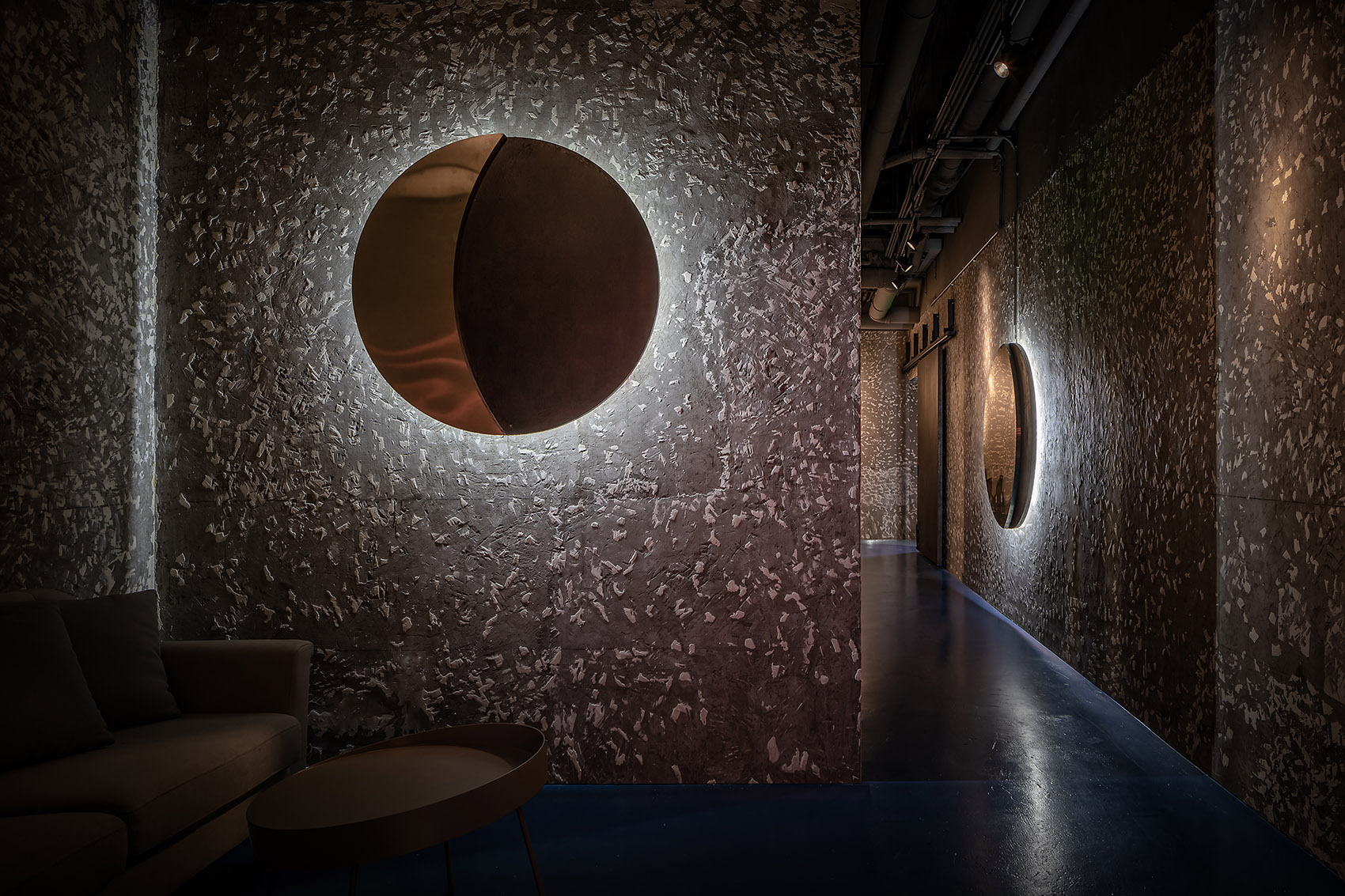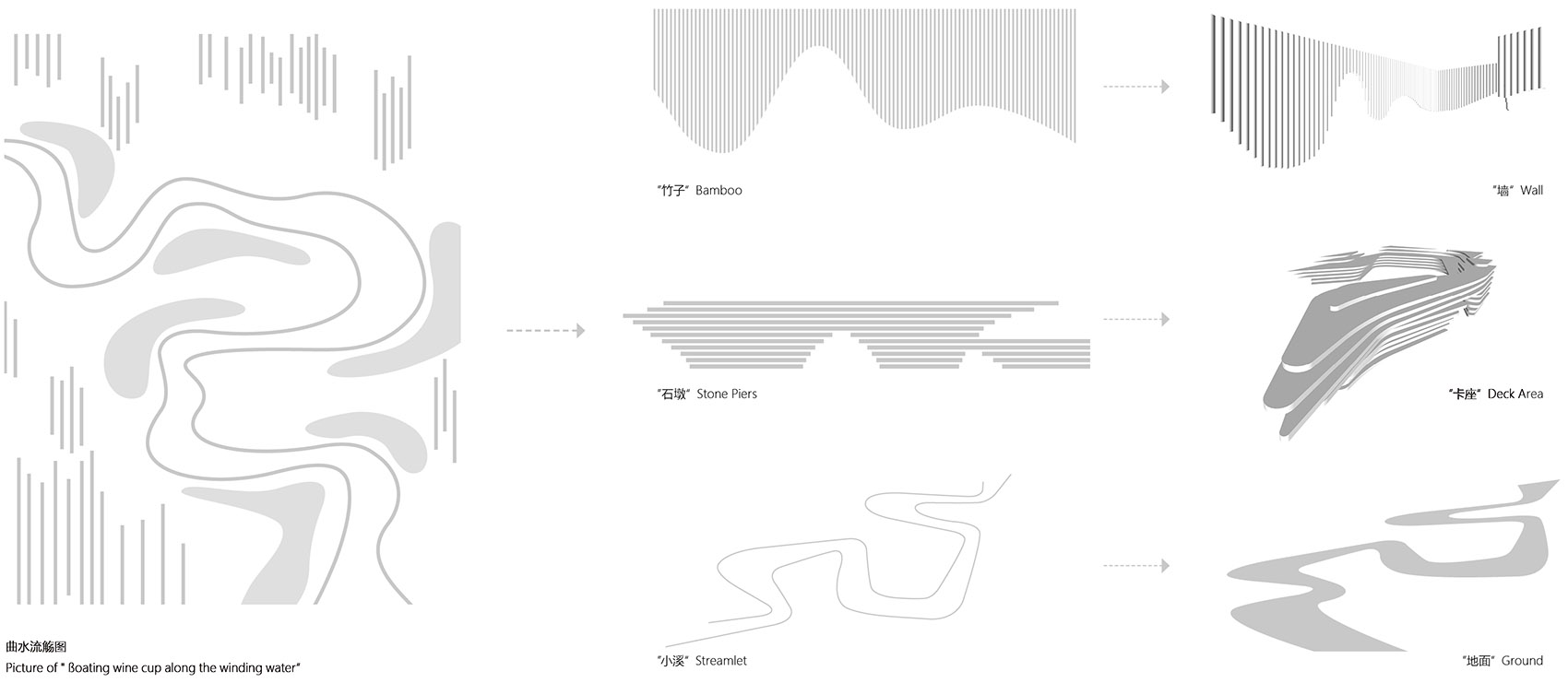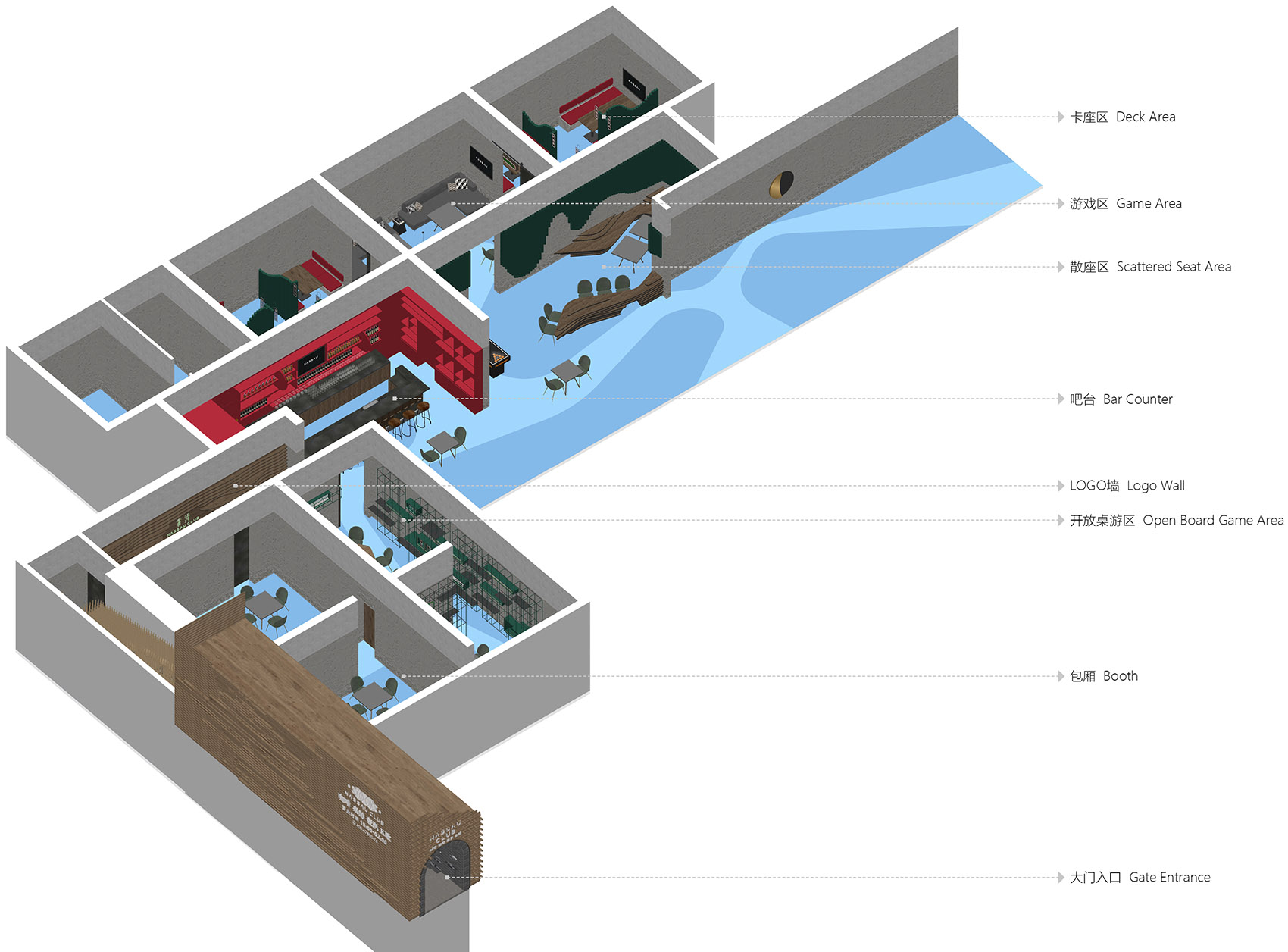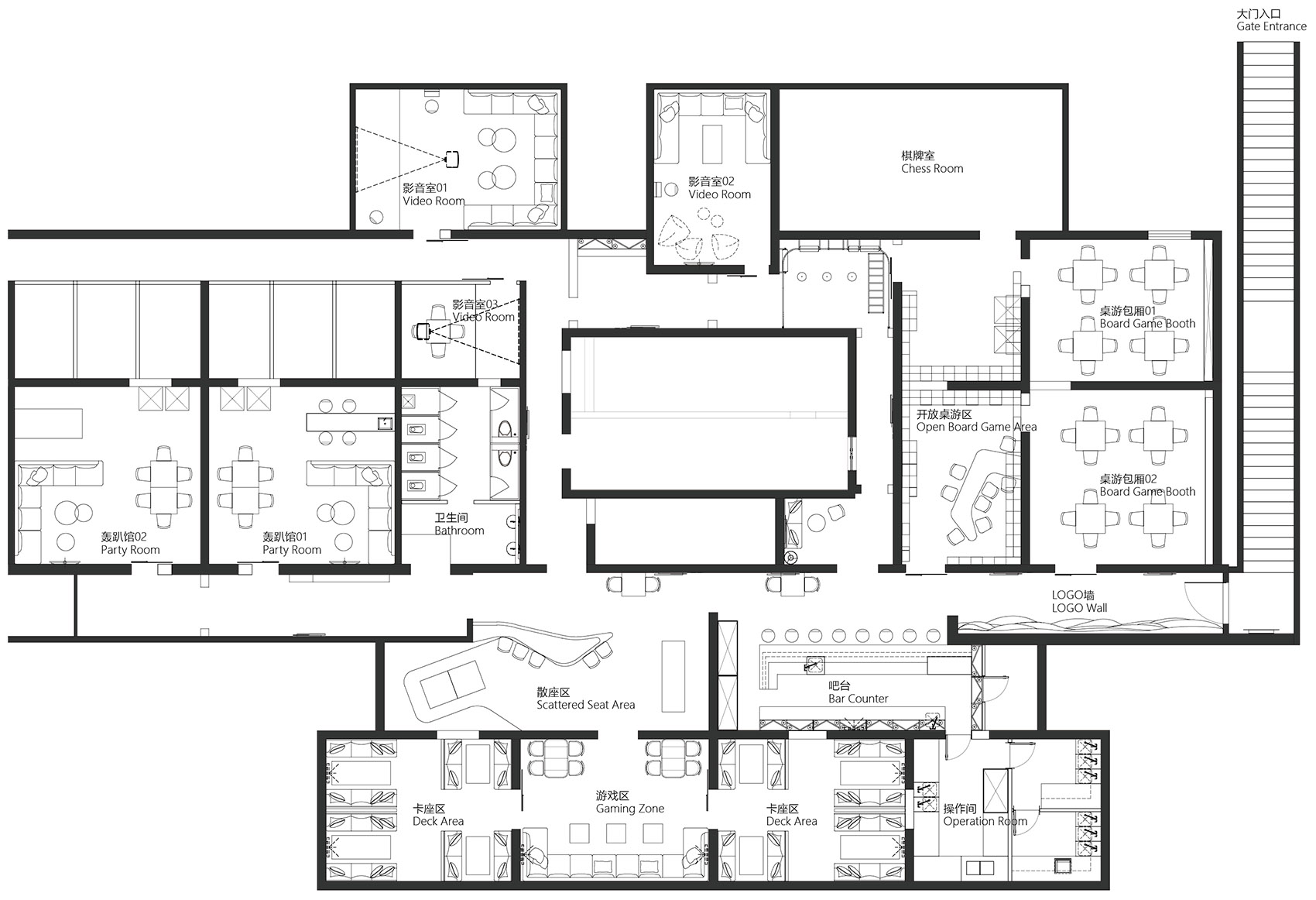“拿骚(Nassau)”是一个位于北京市海淀区的酒吧项目。刚刚接触到这个项目时,它的名字让我们产生了强烈的好奇心。于是业主和我们解释取名的缘由:拿骚是巴哈马的首都,很早以前是加勒比海盗分赃、喝酒、寻欢作乐的场所。这样的场景和现今的年轻人以酒会友,无话不谈的聚落极其相似。
“Nassau” is a club project in Haidian District, Beijing, which aroused our strong curiosity at the first time I saw the name of this project. So, the owner of this club explained the provenance of Nassau, the capital of the Bahamas, was a fun place for the pirates of Caribbean to share their booty, drink, and pursue cakes and ale, which is extremely similar with the scene of young people’s party that talk about anything in the modern life.
▼酒吧入口 Club entrance ©Emma,陈长江
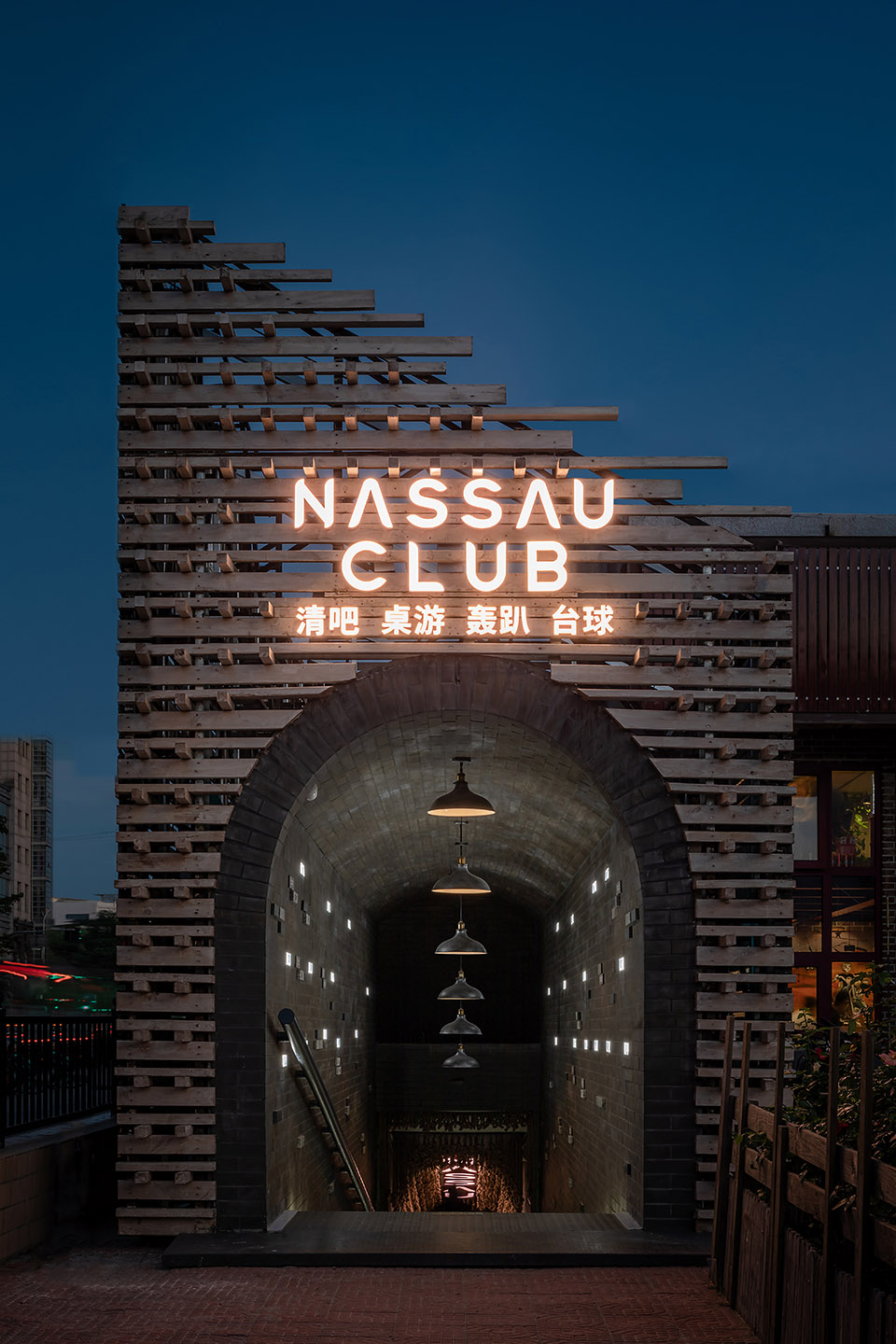
同时在我们看来“拿骚”的“骚”字,也可以让人联想到许多中国文人骚客以酒会友的故事。在这些故事中,以“曲水流觞”的典故最为大家所熟知。王羲之以文会友与大家聚坐在清溪两旁,在上流放置酒杯,酒杯顺流而下,停在谁的面前,谁就要赋诗一首,如若不能则须满饮杯中美酒。于是我们从“曲水流觞”图里提取了竹、石、水这三个元素,再加入月、亭、窗花等中式元素与其相交融。再结合拿骚的海盗文化比如:海洋、海岛、麻绳等概念,通过西方文化和中国文化的碰撞,从而丰富空间的形式语言。
At the same time, in our opinion, the pronunciation of “Nassau” has a syllable of “Sao”, which can also be associated with the stories of many Chinese literati and poets gathering and drinking together. In those stories, the most familiar one is the allusion of ” floating wine cup along the winding water “, that is, When Wang Xizhi and his friends composed poems and sat on both sides of the creek. They put a wine cup in the upper stream of the water, and if the cup came down to the front of someone, this person needs to either write a poem or drink from a glass. So, we enrich the formal language of space through the collision of western and Chinese culture by picking up three elements which are bamboo, stone and water from the picture of ” floating wine cup along the winding water “, adding the Chinese elements such as moon, pavilion and window design, and combining with Nassau’s pirate culture such as ocean, island, rope together.
▼设计概念 Concept ©更新设计

酒吧门口悬挂着酒吧的名称“NASSAU CLUB”,浅粉色的灯光吸引下班后的年轻人到此或小酌或畅饮。门头由海盗船上长短不一的木板纵横交错搭建而成,在光影的投射下形成斑驳的肌理。
The name of the club, NASSAU CLUB, is hung in front of the club, and the rose pink light attracts young to sip or booze after work. The head of the gate is made of varying lengths boards from the pirate ship in the shape of crisscross, forming a mottled texture under the projection of light and shadow.
▼两段不同设计手法的楼梯 Two different design stairs ©Emma,陈长江
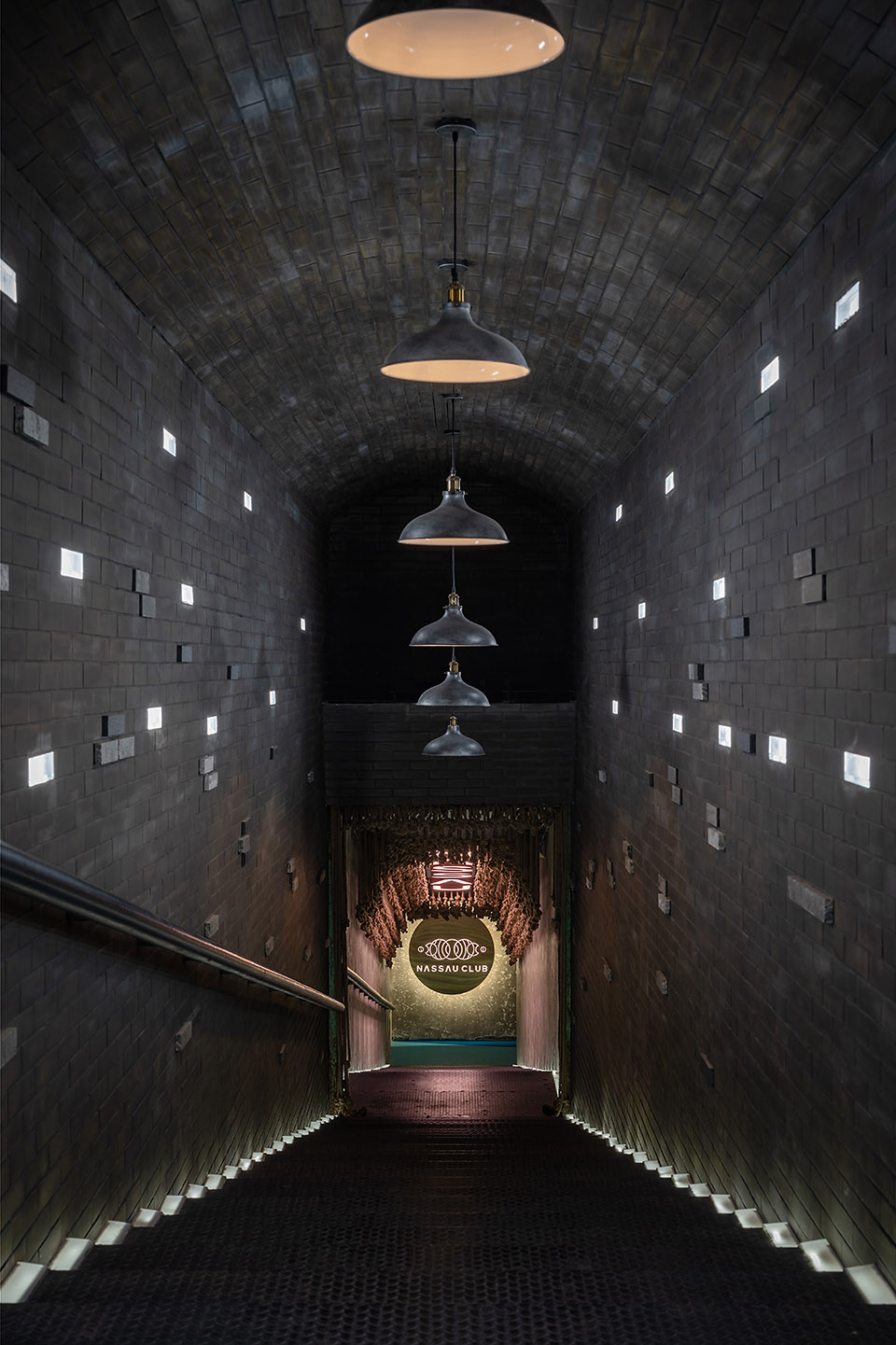
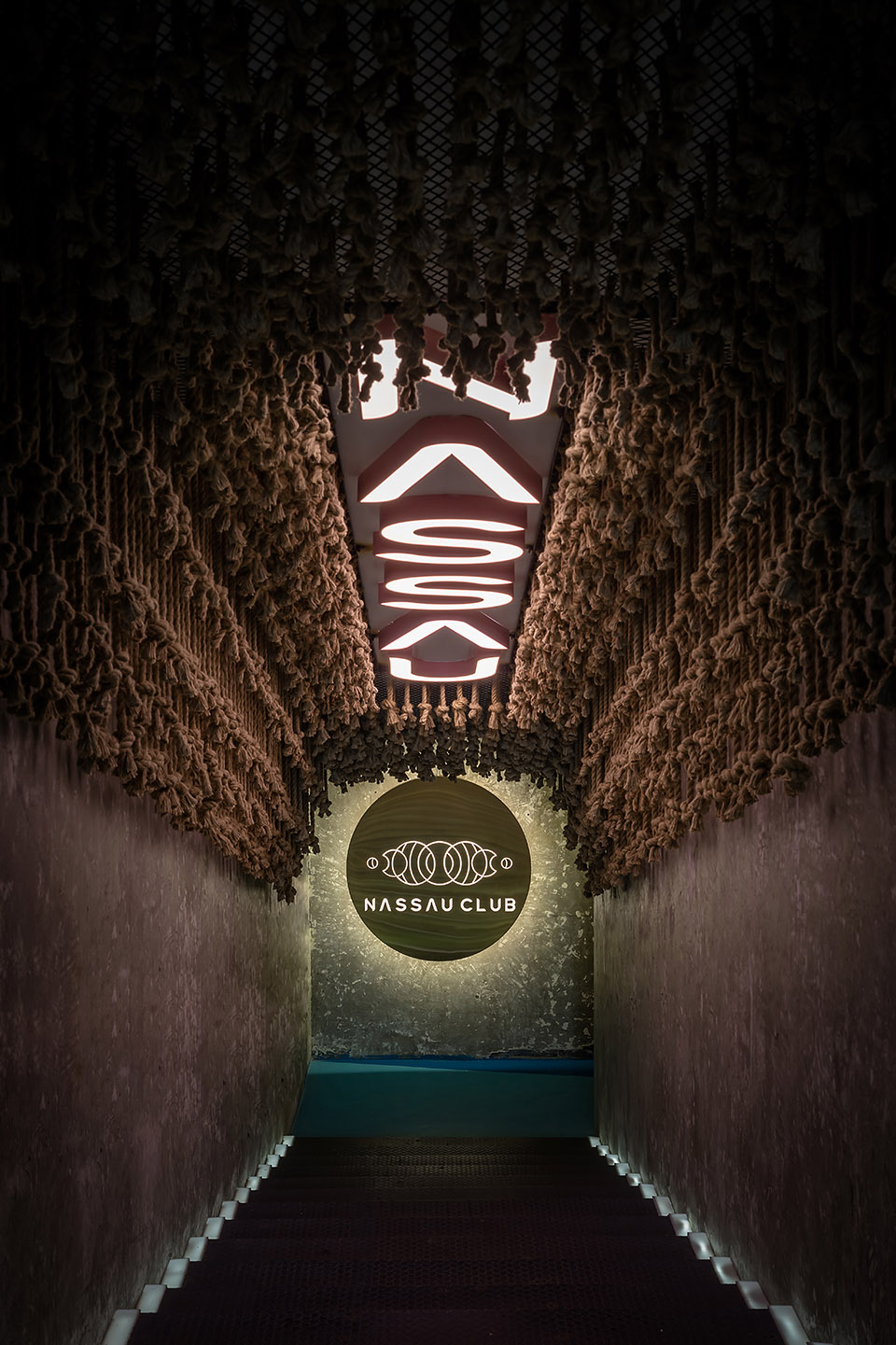
夜幕降临,玉盘似的“满月”悬挂在正中央的墙面上,指引人们进入两段趣味十足的楼梯。第一段楼梯的墙面以青砖为基层,将透光的玻璃砖和纹理不一的石砖,通过错落的手法分散在墙面上。当人们进入第二段楼梯时,便能看到“NASSAU”的霓虹灯悬挂在天花上。海盗船上升帆的工具“麻绳”围绕在四周与其融合在一起,形成一个艺术装置,吸引着人们进入这个神秘的酒吧。
When night falls, a “full moon”, in the shape of a jade plate, is hanging on the centre of the wall, guiding people to the two parts of the interesting stair. The wall tile of the first stair used grey brick as its basic and spread the light-transparent glass bricks and the stone bricks of different textures on the wall randomly. When people enter the second stair, they would saw the neon light of NASSAU hanging over the ceiling. Meanwhile, the “Hemp Rope”, which is pirate ship’s rising rope tool, is blends around neon light to form an art installation that attracting people into this mysterious club.
▼Logo墙 Logo Wall ©Emma,陈长江
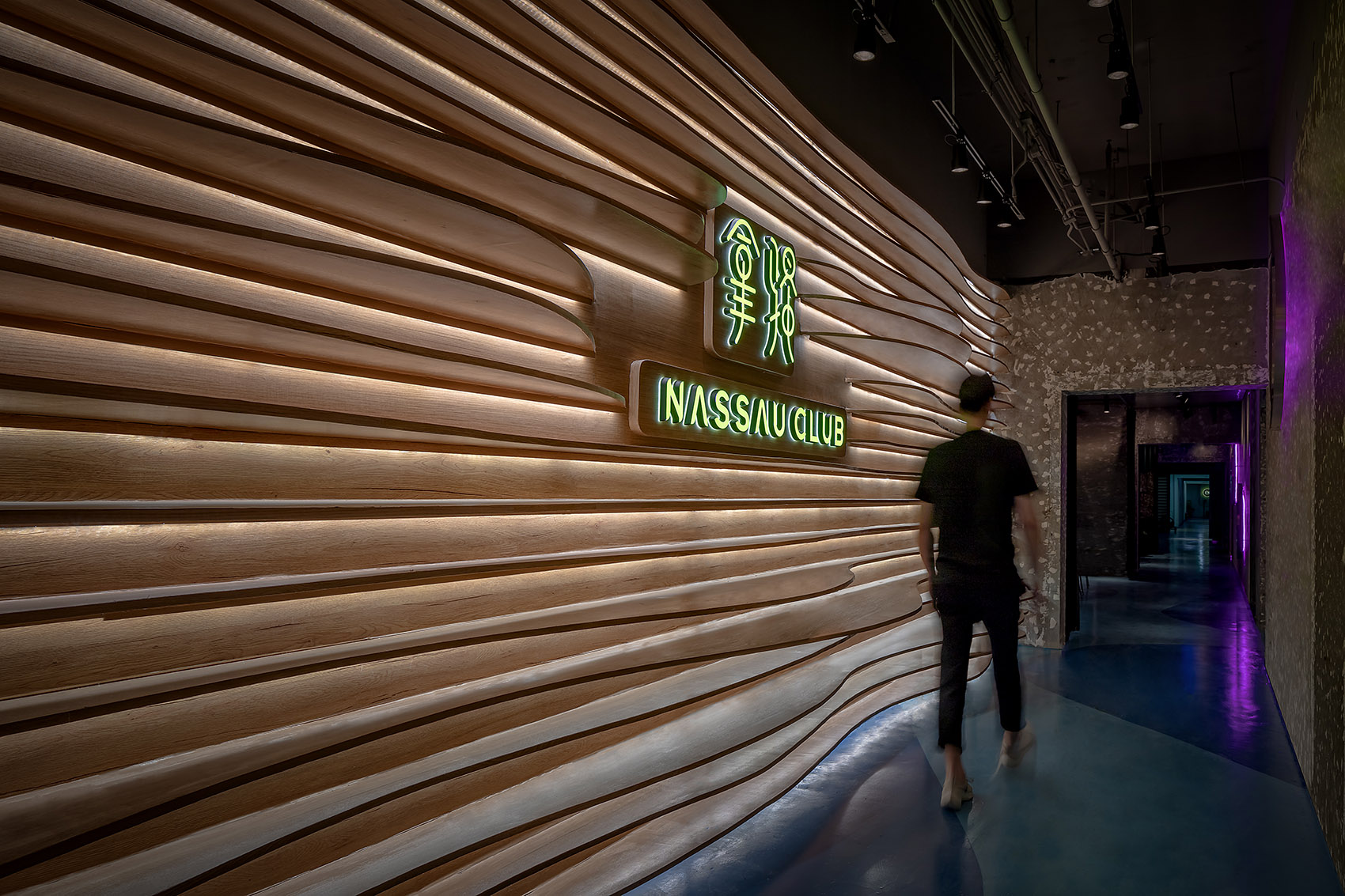
跟随“满月”的指引,进入到酒吧内部。首先进入消费者视线的是酒吧的logo墙,从蜿蜒曲折的流水地面到仿造石墩曲线生成的墙面造型都充分体现着“曲水流觞”的主题概念,让人仿佛置身于山水石林一般。
Follow the lead of “full moon”to the interior of the club. The logo wall is the first thing in consumer’s sight. The theme concept of “floating wine cup along the winding water”is everywhere, not only in the meandering ground of running water but also in the wall furnishings generated from the imitation of the stone curve, making people feel as if they are in landscape and stone forest.
▼吧台区 Bar area ©Emma,陈长江
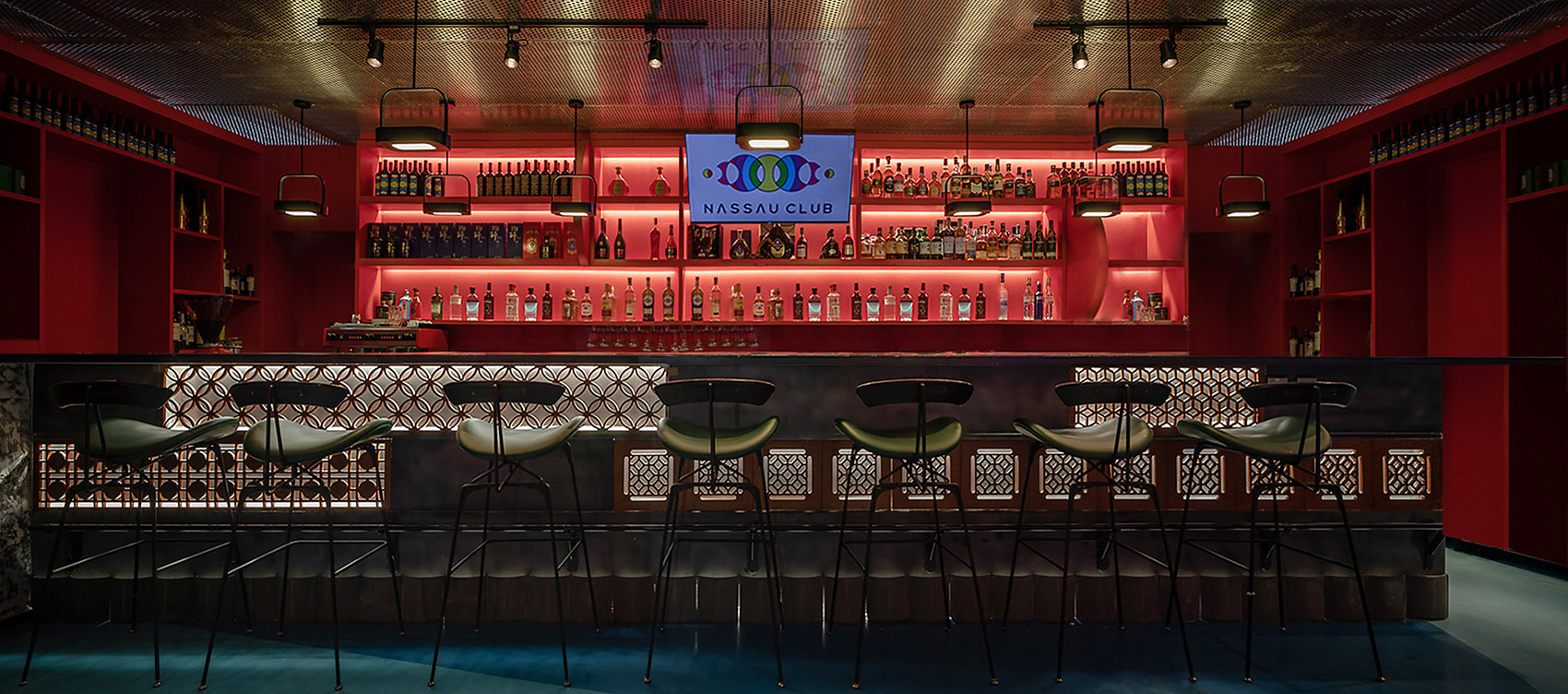
▼吧台局部 Part of bar counter ©Emma,陈长江
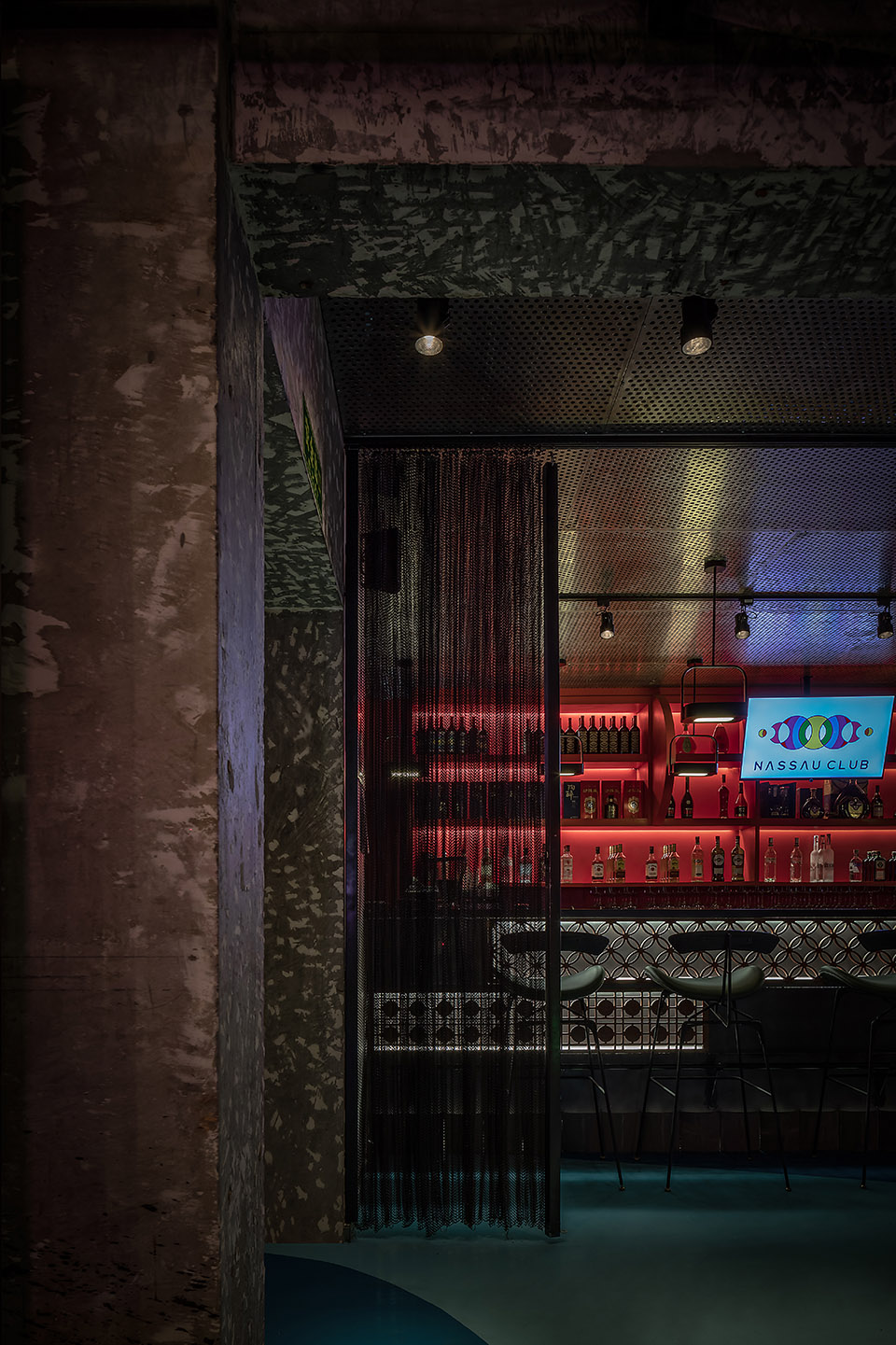
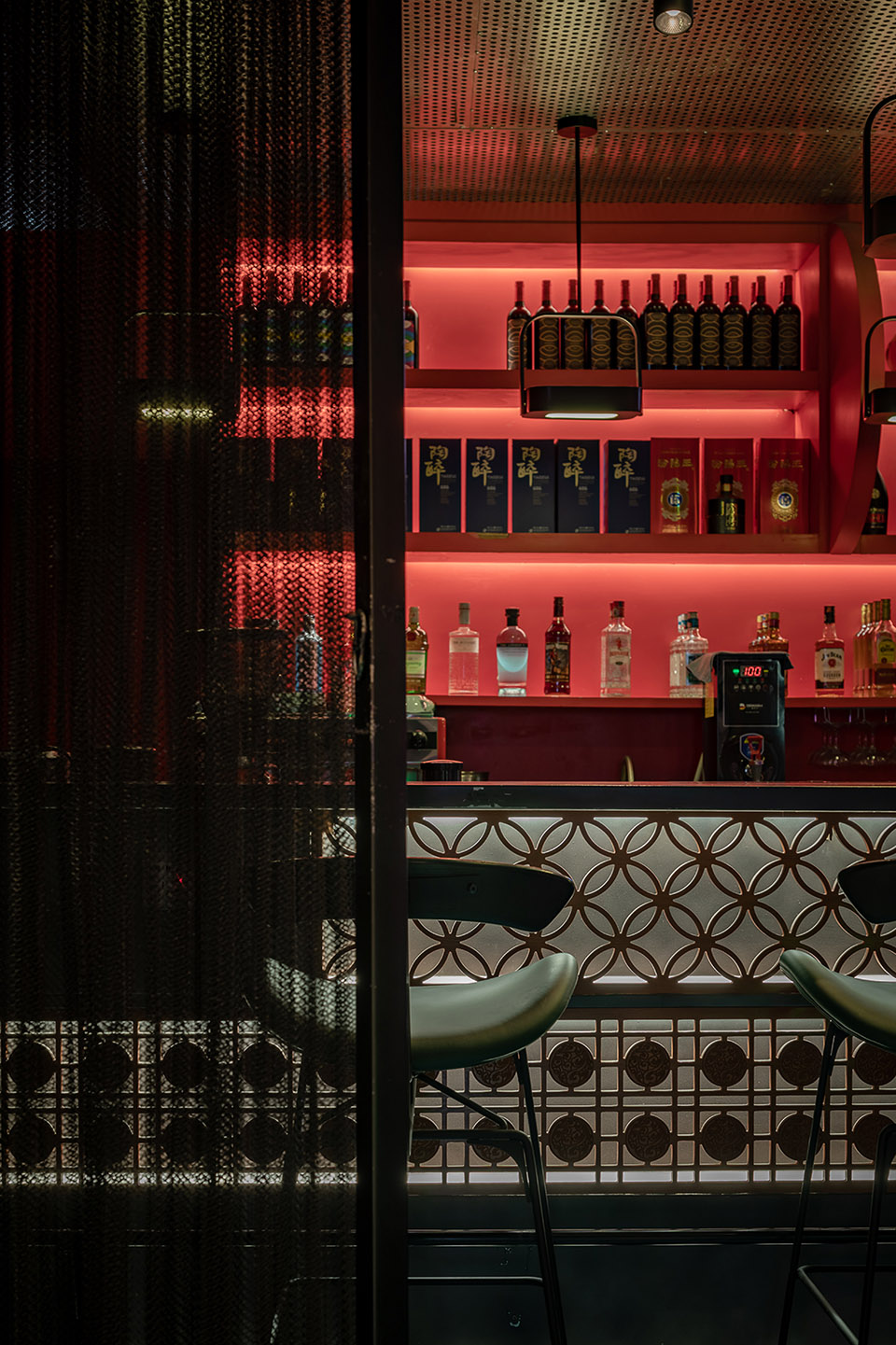
地面的流水将人们引向酒吧的吧台区域。吧台采用了大量形式不一的中式窗花元素,用瓦片当做脚踏,复古又不失趣味。吧台的柜体大胆选用了中国红的色调,加上暖光源的融合,绿色吧椅的点缀,烘托出了地下酒吧的氛围。
The flowing water from the ground leads consumers to the bar counter area. The bar counter has adopted a large amount of different forms of Chinese window elements by using tiles as pedal, which is retro and fun. The cupboard of bar counter boldly choose the color of Chinese red to set off the atmosphere with and the green bar chair.
▼散座区(曲线的墙面造型与吧桌巧妙的融合在一起) Scattered seats area (The curve wall designation and bar table merge together tactfully) ©Emma,陈长江
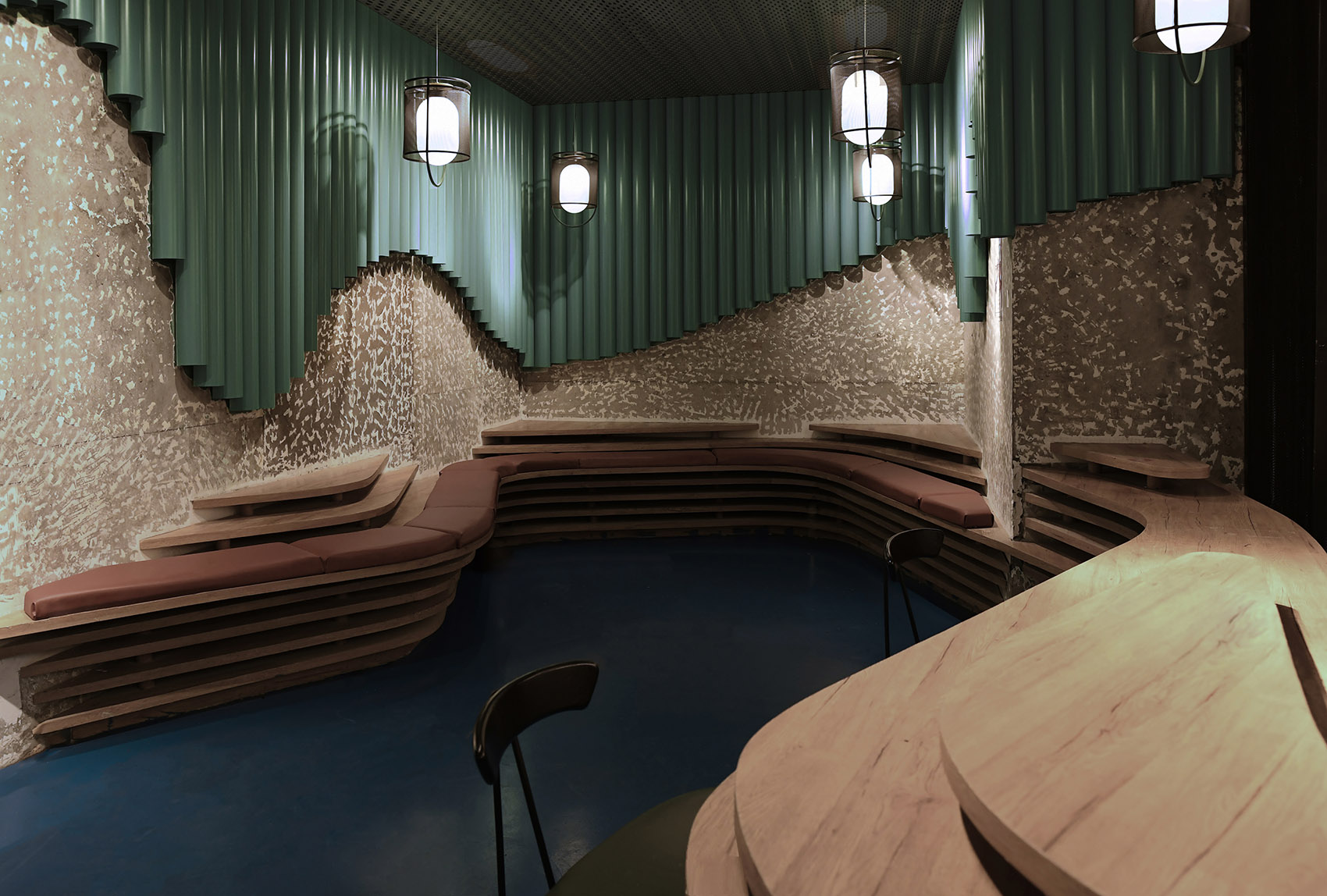
▼墙上如水般的竹林与原有建筑自带斑驳的混凝土形成强烈的碰撞 The water-like bamboo forest on the wall contrast with the original concrete of the building ©Emma,陈长江
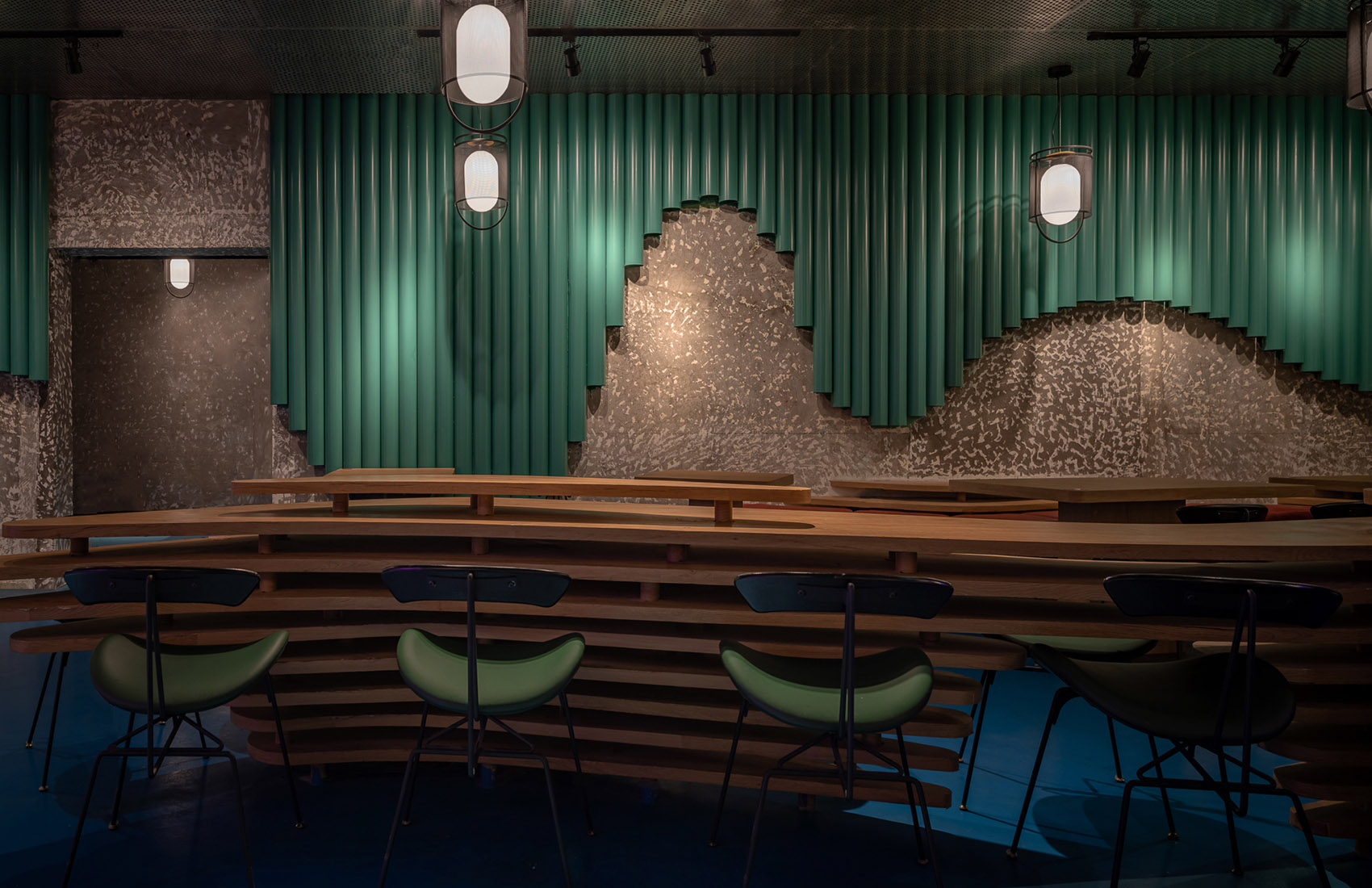
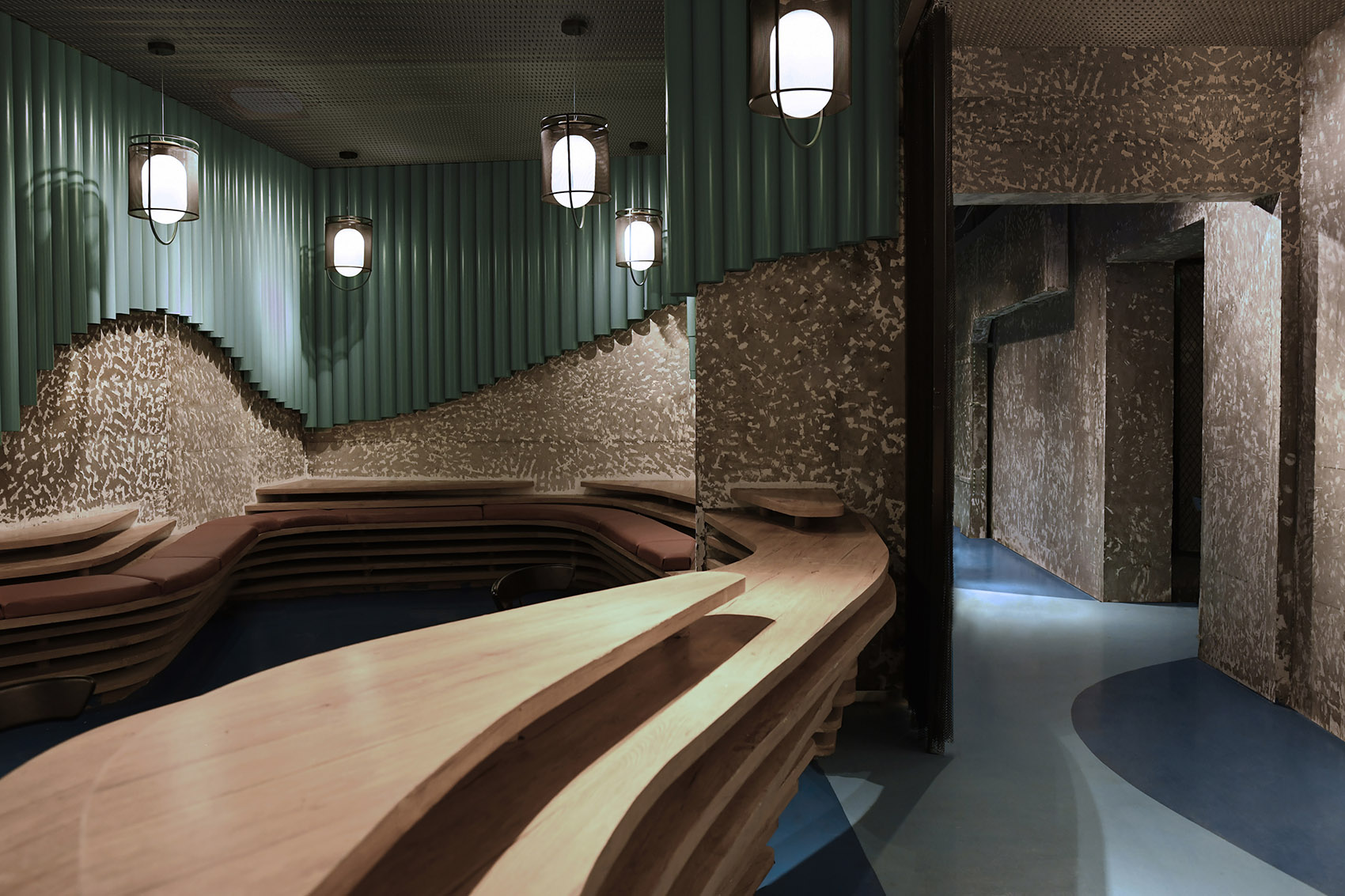
“人生能几月圆时,歌之舞之复蹈之”与朋友一起举杯畅饮,享受其中。酒吧散座区的墙面设计来源于“曲水流觞”图中的“竹”。单纯用竹做墙面造型会显得乏味,于是我们在设计中将“山”的意向结合进来,使空间又增添了几分动感。在“曲水流觞”图中,蜿蜒的清溪旁散布着形状各异的石墩。我们将这些石墩转化为空间中的桌椅,从上到下层层递减,立面轮廓又与墙面上的造型相呼应。而这些石墩又可以被看做是拿骚的海岛,地面上的溪水亦可被视为加勒比的海洋。
“One person can only see a few times of full moon, just sing and dance with it.” Booze with friends, enjoy the wine. The wall design of club’s scattered seats area comes from the “bamboo” in the picture of ” floating wine cup along the winding water “. We add the element of “the mountain” to make the bamboo wall less monotonous and to make the space more dynamic. In the picture of ” floating wine cup along the winding water “, there are many various shapes stone piers winding around the creek. We transformed these stone piers into tables and chairs in the space, descending layer by layer from top to bottom, and the elevation outline echoed the decoration on the wall. Also, these stone piers can be regarded as the islands of Nassau, and the streams on the ground can be regarded as the Caribbean Sea.
▼散座区局部 Part of scattered seats area ©Emma,陈长江


通过卡座区的一个门洞,可以来到相对私密的卡座区。这里延用了散座区的竹林元素,我们将竹林用做卡座的隔断,设计成连绵起伏的山水造型。“翠微亭、沧浪亭、沉香亭、真趣亭、陶然亭、爱晚亭、湖心亭、醉翁亭”为每个卡座的名字。古代元素与现代霓虹灯的碰撞,产生了互相冲突又彼此融合的视觉张力。
Consumers can come to the relatively private booth area through a door hole of the deck area. Here extended the bamboo elements of scattered seats area and used the bamboo partition to block each booth, designing as the rolling landscape mode. The name of each booth is “Cuiwei pavilion, Canglang pavilion, Chenxiang pavilion, Zhenqu pavilion, Taoran pavilion, Aiwan pavilion, Huxin pavilion, Zuiweng pavilion”, which produces the visual tension of conflict and fusion through the collision between the ancient elements and the modern neon lights.
▼通往卡座区的门洞 Door hole connecting to the deck area ©Emma,陈长江
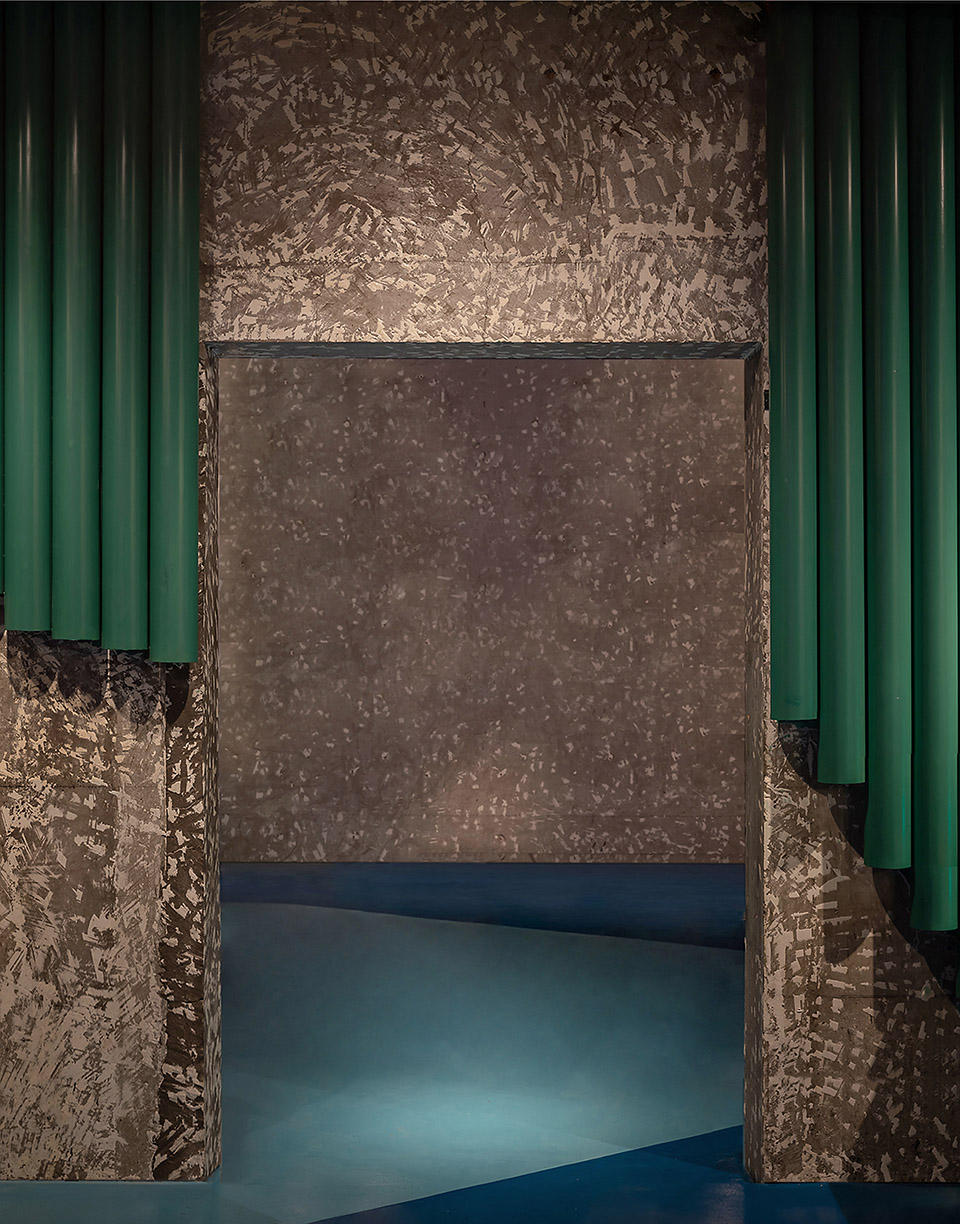
▼卡座区 Deck area ©Emma,陈长江
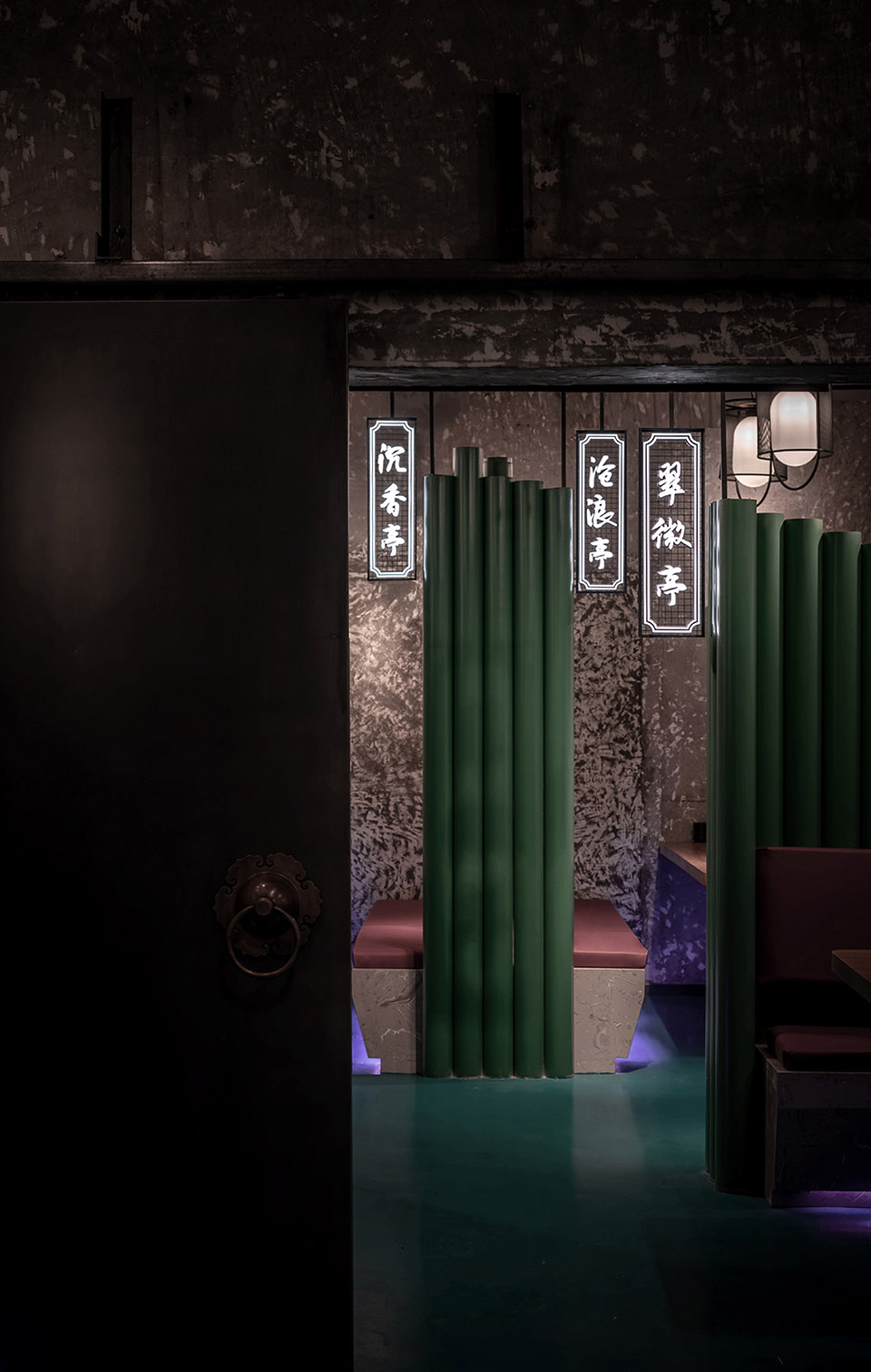
在桌游区我们把中国最古老的桌游“麻将”作为主要的空间元素,将桌游这个舶来品与中国文化结合在了一起。墙面上错落有序的排布着一根根细小的金属圆管,这也是用另一种语言将“竹”元素在空间中再一次呈现。
In the board game area, we use the oldest board game in China, “Mahjong”, as the main space element, and combine an exotic product, the board game, with Chinese culture. On the wall, there are some small metal round tube orderly arranged which is also another kind of language in presenting “bamboo” element in the space.
▼桌游区 Board game area ©Emma,陈长江

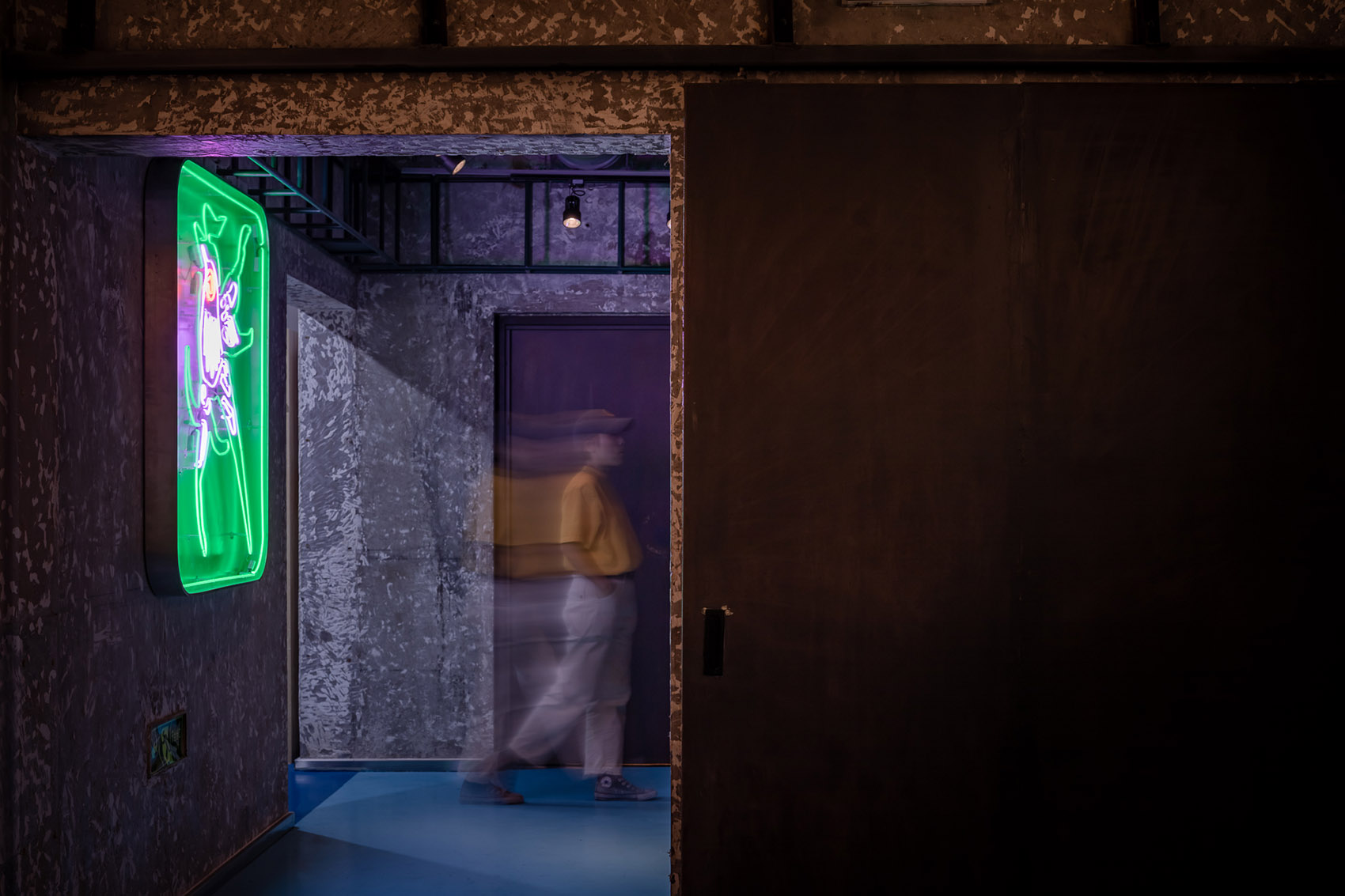
“明月几时有,把酒问青天”,古时文人墨客对着月亮,把酒言欢,创作了很多优美的诗句。而月亮自有阴晴圆缺,这自然的变化也赋予了我们设计灵感。我们用简洁的形式语言将月亮的阴晴圆缺表现出来。从大门入口的“满月”造型到内部逐渐转换的“残月”,各个月亮悬挂在深邃神秘的过道上,既把整个空间串联在一起,也寓意着夜生活的开始和循环往复。
” When the moon put up, raising my cup to ask blue sky.” In ancient times literati and poets talked and drank in front of the moon and created many beautiful poems. The moon will wax, the moon will wane. It gives us inspiration by this natural change. We use concise formal language to show phases of the moon from “full moon” to the gradually changing “waning moon”. Each moon hangs on the deep and mysterious corridor, which not only connecting the whole space, but also implying the start and the circulation of the nightlife.
▼过道(形式不一的月亮坐落在过道中) Corridor (different forms of moon separate in the corridor) ©Emma,陈长江


▼轴测图 Axonometric drawing ©更新设计
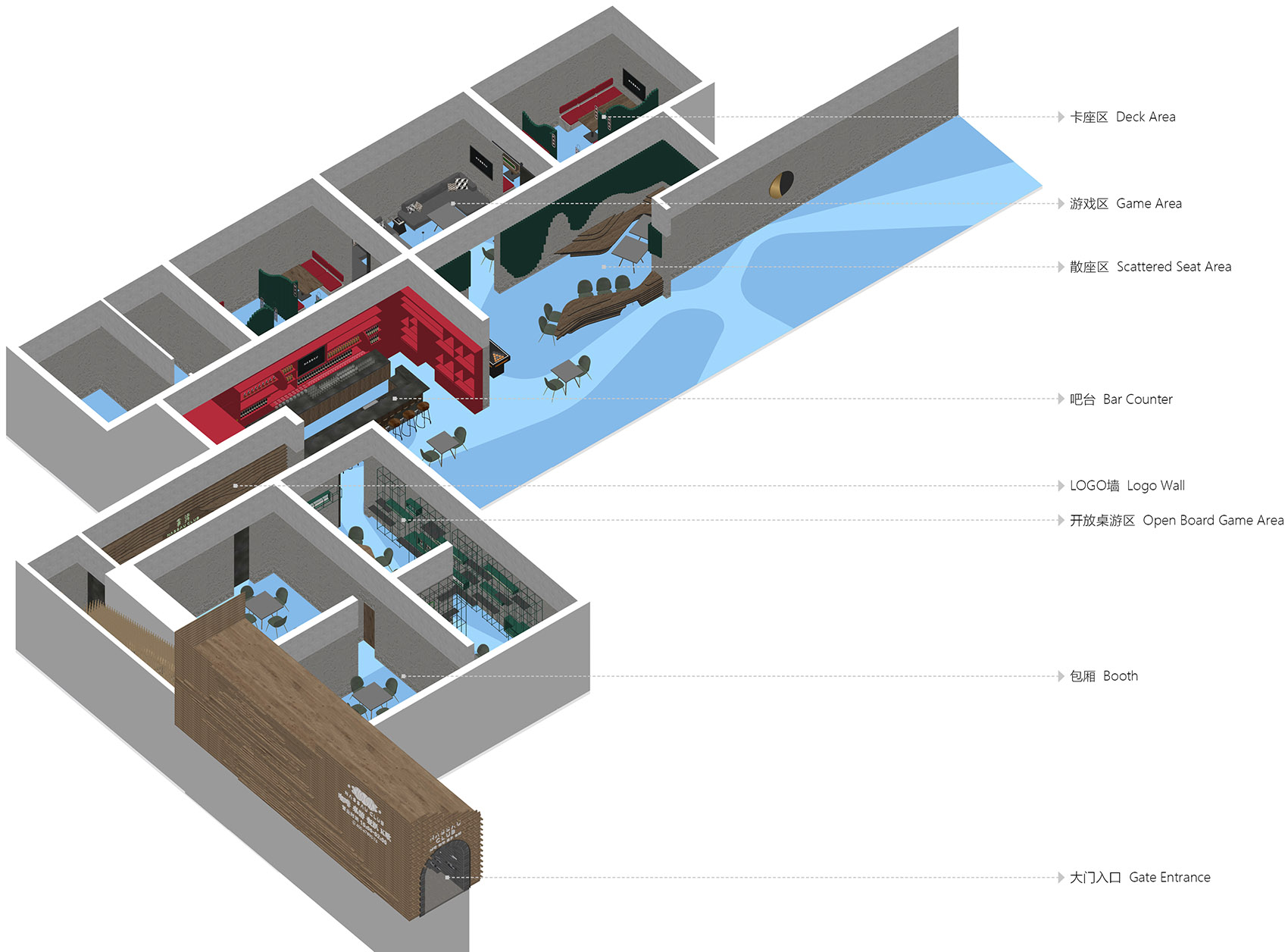
▼平面图 Plan ©更新设计
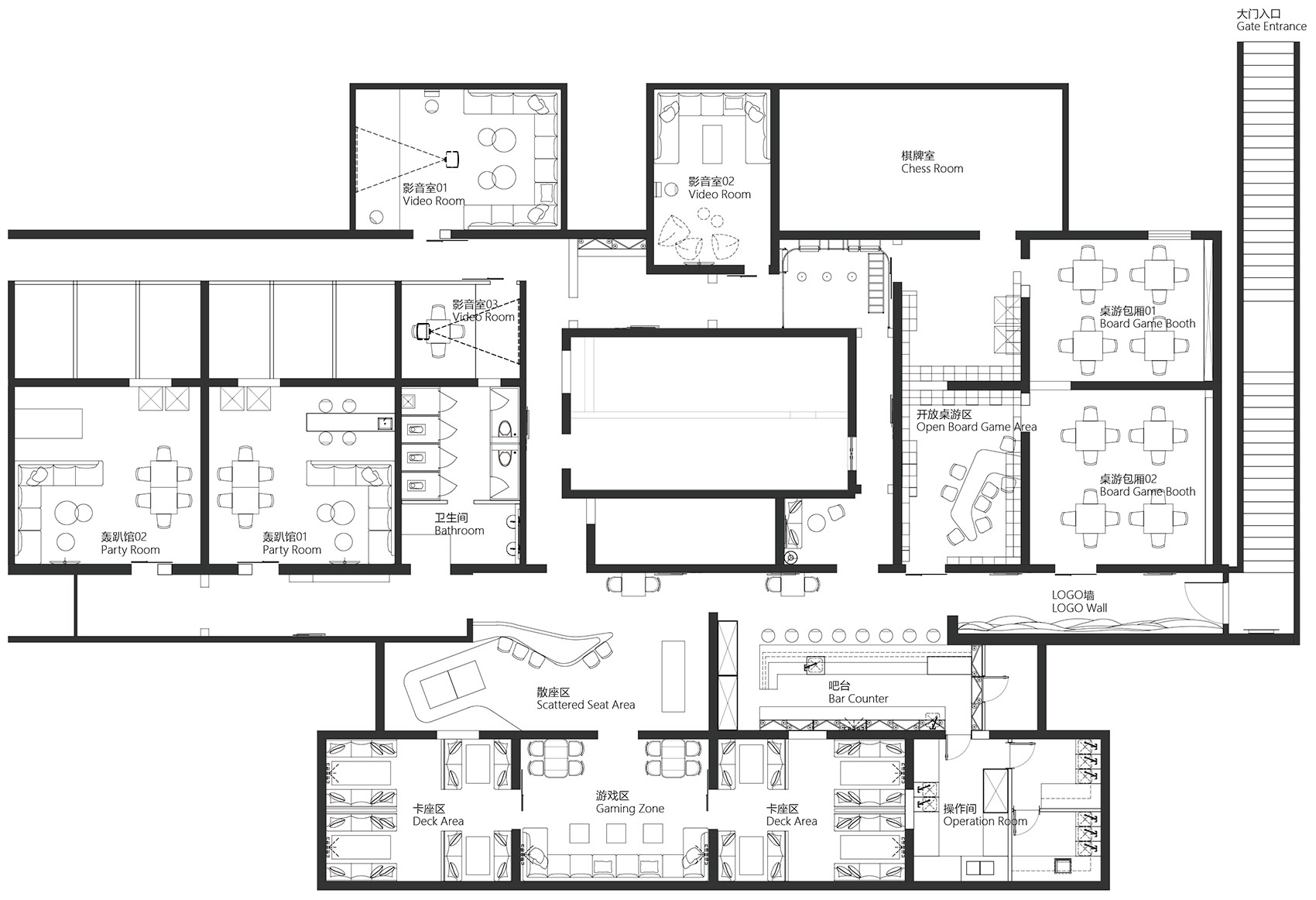
设计公司:更新设计 项目策划:游叔(周游) 设计团队:廖金燕、胡翚羽 业主:国腾投资有限责任公司 地点:北京市海淀区万柳中路 面积:810㎡ 建成时间:2019/08/22
Design company: Update Studio Project planning: You Zhou Design team: Jinyan Liao, Huiyu Hu Owner: Guoteng Investment Co., Ltd. Location: Wanliu Middle Road, Haidian District, Beijing Area: 810㎡ Completion time: 22/8/2019


